
List of birds of Chile
Encyclopedia
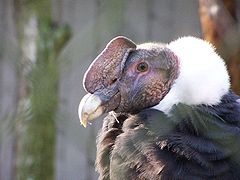
Chile
Chile ,officially the Republic of Chile , is a country in South America occupying a long, narrow coastal strip between the Andes mountains to the east and the Pacific Ocean to the west. It borders Peru to the north, Bolivia to the northeast, Argentina to the east, and the Drake Passage in the far...
includes a total of 479 species (324 non-passerines and 155 passerines), of which 12 are endemic
Endemism in birds
An endemic bird area is a region of the world that contains two or more restricted-range species, while a "secondary area" contains one or more restricted-range species. Both terms were devised by Birdlife International....
(with 8 species belonging to the suborder Tyranni
Tyranni
The suborder of passerine birds Tyranni includes about 1,000 species, the large majority of which are South American. It is named after the type genus Tyrannus....
), 6 have been introduced
Introduced species
An introduced species — or neozoon, alien, exotic, non-indigenous, or non-native species, or simply an introduction, is a species living outside its indigenous or native distributional range, and has arrived in an ecosystem or plant community by human activity, either deliberate or accidental...
by humans, and 88 are rare or accidental. 33 species are globally threatened. The list includes species recorded on Easter Island
Easter Island
Easter Island is a Polynesian island in the southeastern Pacific Ocean, at the southeasternmost point of the Polynesian triangle. A special territory of Chile that was annexed in 1888, Easter Island is famous for its 887 extant monumental statues, called moai, created by the early Rapanui people...
, Sala y Gómez
Sala y Gómez
Isla Salas y Gómez, also known as Isla Sala y Gómez, is a small uninhabited Chilean island in the Pacific Ocean. It is the easternmost point in the Polynesian Triangle...
, the Juan Fernández Islands
Juan Fernández Islands
The Juan Fernández Islands are a sparsely inhabited island group reliant on tourism and fishing in the South Pacific Ocean, situated about off the coast of Chile, and is composed of three main volcanic islands; Robinson Crusoe Island, Alejandro Selkirk Island and Santa Clara Island, the first...
and the Chilean Antarctic Territory.
This list's taxonomic
Taxonomy
Taxonomy is the science of identifying and naming species, and arranging them into a classification. The field of taxonomy, sometimes referred to as "biological taxonomy", revolves around the description and use of taxonomic units, known as taxa...
treatment (designation and sequence of orders, families, and species) and nomenclature (common and scientific names) follow the conventions of Clements
James Clements
Dr. James Franklin Clements was an ornithologist, author and very successful businessman. He was born in New York....
's 5th edition. The family accounts at the beginning of each heading reflects this taxonomy, as do the species counts found in each family account. Introduced and accidental species are included in the total counts for Chile.
The following tags have been used to highlight certain relevant categories, but not all species fall into one of these categories. Those that do not are commonly occurring, native species.
- (A) Accidental A species that rarely or accidentally occurs in Chile.
- (E) Endemic A species endemic to Chile.
- (I) Introduced A species introduced to Chile as a consequence, direct or indirect, of human actions.
- (Ant) Antarctic A species recorded from the Chilean Antarctic Territory but not from Chile proper.
| Table of contents |
|---|
Non-passerines: Rheas . Tinamous . Penguins . Grebes . Albatrosses . Shearwaters and Petrels . Storm-Petrels . Diving petrels . Tropicbirds . Pelicans . Boobies and Gannets . Cormorants . Frigatebirds . Bitterns, Herons and Egrets . Storks . Ibises and Spoonbills . Flamingos . Ducks, Geese and Swans . New World vultures . Osprey . Hawks, Kites and Eagles . Caracaras and Falcons . New World quails . Pheasants and Partridges . Rails, Crakes, Gallinules, and Coots . Jacanas . Painted snipe . Oystercatchers . Avocets and Stilts . Thick-knees . Plovers and Lapwings . Magellanic Plover . Sandpipers and allies . Seedsnipes . Sheathbills . Skuas and Jaegers . Gulls . Terns . Skimmers . Pigeons and Doves . Parrots, Macaws and allies . Cuckoos and Anis . Barn owls . Typical owls . Nightjars . Swifts . Hummingbirds . Kingfishers . Woodpeckers and allies . |
Passerines: Ovenbirds . Tapaculos . Cotingas . Tyrant flycatchers . Swallows and Martins . Wagtails and Pipits . Wrens . Mockingbirds and Thrashers . Thrushes and allies . Vireos . New World warblers . Tanagers . Buntings, Sparrows, Seedeaters and allies . Saltators, Cardinals and allies . Troupials and allies . Siskins, Crossbills and allies . Sparrows . |
See also References |
Rheas

The rheas are large flightless birds native to South America. Their feet have three toes rather than four which allows them to run faster. There are 2 species and 1 species which occurs in Chile.
- Lesser Rhea Rhea pennata
Tinamous
Order: Tinamiformes. Family: TinamidaeThe tinamous are one of the most ancient groups of bird. Although they look similar to other ground-dwelling birds like quail and grouse, they have no close relatives and are classified as a single family Tinamidae within their own order, the Tinamiformes. They are distantly related to the ratites (order Struthioniformes), that includes the rhea
Rhea (bird)
The rheas are ratites in the genus Rhea, native to South America. There are two existing species: the Greater or American Rhea and the Lesser or Darwin's Rhea. The genus name was given in 1752 by Paul Möhring and adopted as the English common name. Möhring's reason for choosing this name, from the...
s, emu
Emu
The Emu Dromaius novaehollandiae) is the largest bird native to Australia and the only extant member of the genus Dromaius. It is the second-largest extant bird in the world by height, after its ratite relative, the ostrich. There are three subspecies of Emus in Australia...
, and kiwi
Kiwi
Kiwi are flightless birds endemic to New Zealand, in the genus Apteryx and family Apterygidae.At around the size of a domestic chicken, kiwi are by far the smallest living ratites and lay the largest egg in relation to their body size of any species of bird in the world...
. There are 47 species worldwide and 6 species which occur in Chile.
- Ornate TinamouOrnate TinamouThe Ornate Tinamou, Nothoprocta ornata, is a type of Tinamou commonly found in the high altitude grassland and dry shrubland in subtropical and tropical regions of west central South America.-Etymology:...
Nothoprocta ornata - Chilean TinamouChilean TinamouThe Chilean Tinamou, Nothoprocta perdicaria, is a type of tinamou commonly found in high altitude shrubland in subtropical regions of central Chile.-Etymology:...
Nothoprocta perdicaria (E) - Andean TinamouAndean TinamouThe Andean Tinamou is a tinamou, found commonly in high altitude shrubland, in the Andes of South America.-Etymology:...
Nothoprocta pentlandii - Elegant Crested TinamouElegant Crested TinamouThe Elegant Crested Tinamou or Martineta Tinamou, Eudromia elegans, is a medium-sized tinamou that can be found in southern Chile and Argentina in shrubland.-Etymology:...
Eudromia elegans - Puna TinamouPuna TinamouThe Puna Tinamou, Tinamotis pentlandii also known as Pentland’s Tinamou is a member of the most ancient groups of bird families, the tinamous. This species is native to southern South America.-Taxonomy:...
Tinamotis pentlandii - Patagonian TinamouPatagonian TinamouThe Patagonian Tinamou, Tinamotis ingoufi, also known as Ingouf’s Tinamou is a member of the most ancient group of bird families, the tinamous. This species is native to southern South America-Taxonomy:...
Tinamotis ingoufi
Penguins

The penguins are a group of aquatic, flightless birds living almost exclusively in the Southern Hemisphere. Most penguins feed on krill
Krill
Krill is the common name given to the order Euphausiacea of shrimp-like marine crustaceans. Also known as euphausiids, these small invertebrates are found in all oceans of the world...
, fish
Fish
Fish are a paraphyletic group of organisms that consist of all gill-bearing aquatic vertebrate animals that lack limbs with digits. Included in this definition are the living hagfish, lampreys, and cartilaginous and bony fish, as well as various extinct related groups...
, squid
Squid
Squid are cephalopods of the order Teuthida, which comprises around 300 species. Like all other cephalopods, squid have a distinct head, bilateral symmetry, a mantle, and arms. Squid, like cuttlefish, have eight arms arranged in pairs and two, usually longer, tentacles...
, and other forms of sealife caught while swimming underwater. There are 17 species worldwide and 10 species which occur in Chile.
- King PenguinKing PenguinThe King Penguin is the second largest species of penguin at about , second only to the Emperor Penguin. There are two subspecies—A. p. patagonicus and A. p...
Aptenodytes patagonicus - Emperor PenguinEmperor PenguinThe Emperor Penguin is the tallest and heaviest of all living penguin species and is endemic to Antarctica. The male and female are similar in plumage and size, reaching in height and weighing anywhere from . The dorsal side and head are black and sharply delineated from the white belly,...
Aptenodytes forsteri (A) - Gentoo PenguinGentoo penguinThe Gentoo Penguin , Pygoscelis papua, is easily recognized by the wide white stripe extending like a bonnet across the top of its head and its bright orange-red bill. The gentoo penguin has pale whitish-pink webbed feet and a fairly long tail - the most prominent tail of all penguins. Chicks have...
Pygoscelis papua - Adelie PenguinAdelie PenguinThe Adélie Penguin, Pygoscelis adeliae, is a species of penguin common along the entire Antarctic coast. They are among the most southerly distributed of all seabirds, as are the Emperor Penguin, the South Polar Skua, the Wilson's Storm Petrel, the Snow Petrel, and the Antarctic Petrel...
Pygoscelis adeliae (Ant) - Chinstrap PenguinChinstrap PenguinThe Chinstrap Penguin is a species of penguin which is found in the South Sandwich Islands, Antarctica, the South Orkneys, South Shetland, South Georgia, Bouvet Island and Balleny...
Pygoscelis antarctica - Rockhopper PenguinRockhopper penguinThe rockhopper penguins are three closely related taxa of crested penguins that have been traditionally treated as a single species and are sometimes split into two or three species. Not all experts agree on the classification of these penguins...
Eudyptes chrysocome - Macaroni PenguinMacaroni PenguinThe Macaroni Penguin is a species of penguin found from the Subantarctic to the Antarctic Peninsula. One of six species of crested penguin, it is very closely related to the Royal Penguin, and some authorities consider the two to be a single species...
Eudyptes chrysolophus - Little PenguinLittle PenguinThe Little Penguin is the smallest species of penguin. The penguin, which usually grows to an average of in height and in length , is found on the coastlines of southern Australia and New Zealand, with possible records from Chile.Apart from Little Penguins, they have several common names...
Eudyptula minor (A) - Humboldt PenguinHumboldt PenguinThe Humboldt Penguin is a South American penguin, that breeds in coastal Peru and Chile. Its nearest relatives are the African Penguin, the Magellanic Penguin and the Galápagos Penguin...
Spheniscus humboldti - Magellanic PenguinMagellanic PenguinThe Magellanic Penguin, Spheniscus magellanicus, is a South American penguin, breeding in coastal Argentina, Chile and the Falkland Islands, with some migrating to Brazil where they are occasionally seen as far north as Rio de Janeiro. It is the most numerous of the Spheniscus penguins. Its nearest...
Spheniscus magellanicus
Grebes
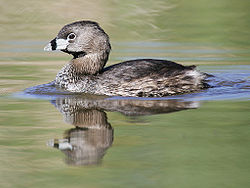
Grebe
Grebe
A grebe is a member of the Podicipediformes order, a widely distributed order of freshwater diving birds, some of which visit the sea when migrating and in winter...
s are small to medium-large sized freshwater diving birds. They have lobed toes, and are excellent swimmers and divers. However, they have their feet placed far back on the body, making them quite ungainly on land. There are 20 species worldwide and 5 species which occur in Chile.
- Pied-billed GrebePied-billed GrebeThe Pied-billed Grebe is a species of the grebe family of water birds. Since the Atitlán Grebe, Podilymbus gigas, has become extinct, it is the sole extant member of the genus Podilymbus.-Description:...
Podilymbus podiceps - White-tufted GrebeWhite-tufted GrebeThe White-tufted Grebe is a species of grebe in the Podicipedidae family.It is found in Argentina, Bolivia, Brazil, Chile, Falkland Islands, Paraguay, Peru, and Uruguay.Its natural habitat is freshwater lakes.-References:...
Rollandia rolland - Great GrebeGreat GrebeThe Great Grebe is the largest species of grebe on earth. A disjunct population exists in northwestern Peru, while the main distribution is from extreme southeastern Brazil to Patagonia and central Chile. The population from southern Chile is considered a separate subspecies, P. m. navasi.This...
Podiceps major - Silvery GrebeSilvery GrebeThe Silvery Grebe is a species of grebe in the Podicipedidae family.It is found in Argentina, Chile, the Falkland Islands and Paraguay as well as Andean regions of Bolivia, Colombia, Ecuador and Peru. It is a vagrant to Brazil....
Podiceps occipitalis - Hooded GrebeHooded GrebeThe Hooded Grebe , is a medium-sized grebe found in the southern region of South America. It grows to about 34 cm in length, and is black and white in color...
Podiceps gallardoi (A)
Albatrosses
Order: ProcellariiformesProcellariiformes
Procellariiformes is an order of seabirds that comprises four families: the albatrosses, petrels and shearwaters, storm petrels, and diving petrels...
. Family: Diomedeidae
The albatrosses are among the largest of flying birds, and the great albatrosses from the genus Diomedea have the largest wingspans of any extant birds. There are 21 species worldwide and 9 species which occur in Chile.
- Wandering AlbatrossWandering AlbatrossThe Wandering Albatross, Snowy Albatross or White-winged Albatross, Diomedea exulans, is a large seabird from the family Diomedeidae, which has a circumpolar range in the Southern Ocean. It was the first species of albatross to be described, and was long considered the same species as the Tristan...
Diomedea exulans - Royal AlbatrossRoyal AlbatrossRoyal Albatross may refer to:* Northern Royal Albatross* Southern Royal AlbatrossNote: Some authorities have yet to split this species such as the SACC or James Clements, in that case, Royal Albatross refers to both Species....
Diomedea epomophora - Waved AlbatrossWaved AlbatrossThe Waved Albatross, Phoebastria irrorata - also known as Galapagos Albatross - is the only member of the Diomedeidae family located in the tropics. When they forage, the Waved Albatross follow straight paths to a single site off the coast of Peru, about distant to the east...
Phoebastria irrorata - Gray-headed Albatross Thalassarche chrysostoma
- Chatham AlbatrossChatham AlbatrossThe Chatham Albatross, Chatham Mollymawk, or Chatham Islands Mollymawk, Thalassarche eremita, is a medium-sized black-and-white albatross which breeds only on The Pyramid, a large rock stack in the Chatham Islands, New Zealand. It is sometimes treated as a subspecies of the Shy Albatross...
Thalassarche eremita - Black-browed AlbatrossBlack-browed AlbatrossThe Black-browed Albatross or Black-browed Mollymawk, Thalassarche melanophrys, is a large seabird of the albatross family Diomedeidae, and it is the most widespread and common albatross.-Taxonomy:...
Thalassarche melanophris - Buller's AlbatrossBuller's AlbatrossBuller's Albatross or Buller's Mollymawk, Thalassarche bulleri, is a small mollymawk in the albatross family. It breeds on islands around New Zealand, and feeds in the seas off Australia and the South Pacific.-Taxonomy:...
Thalassarche bulleri - Shy AlbatrossShy AlbatrossThe Shy Albatross or Shy Mollymawk, Thalassarche cauta, is a medium sized albatross that breeds off Australia and New Zealand's sub-Antarctic islands and ranges extensively across the Southern Ocean...
Thalassarche cauta - Sooty AlbatrossSooty AlbatrossThe Sooty Albatross, Dark-mantled Sooty Albatross or Dark-mantled Albatross, Phoebetria fusca, is a species of bird in the albatross family...
Phoebetria fusca (A) - Light-mantled AlbatrossLight-mantled AlbatrossThe Light-mantled Albatross, Phoebetria palpebrata, also known as the Grey-mantled Albatross or the Light-mantled Sooty Albatross, is a small albatross in the genus Phoebetria, which it shares with the Sooty Albatross...
Phoebetria palpebrata
Shearwaters and petrels

Procellariiformes
Procellariiformes is an order of seabirds that comprises four families: the albatrosses, petrels and shearwaters, storm petrels, and diving petrels...
. Family: Procellariidae
Procellariidae
The family Procellariidae is a group of seabirds that comprises the fulmarine petrels, the gadfly petrels, the prions, and the shearwaters. This family is part of the bird order Procellariiformes , which also includes the albatrosses, the storm-petrels, and the diving petrels.The procellariids are...
The procellariids are the main group of medium-sized 'true petrels', characterised by united nostrils with a medium septum, and a long outer functional primary. There are 75 species worldwide and 33 species which occur in Chile.
- Antarctic Giant Petrel Macronectes giganteus
- Hall's Giant Petrel Macronectes halli
- Southern FulmarSouthern FulmarThe Southern Fulmar, Fulmarus glacialoides, is a seabird of the Southern Hemisphere. Along with the Northern Fulmar, F. glacialis, it belongs to the fulmar genus Fulmarus in the family Procellariidae, the true petrels...
Fulmarus glacialoides - Antarctic PetrelAntarctic PetrelThe Antarctic Petrel is a boldly marked dark brown and white petrel, found in Antarctica, most commonly in the Ross and Weddell seas. They eat Antarctic krill, fish, and small squid...
Thalassoica antarctica (A) - Cape PetrelCape PetrelThe Cape Petrel also called Cape Pigeon or Pintado Petrel, is a common seabird of the Southern Ocean from the family Procellariidae. It is the only member of the genus Daption, and is allied to the fulmarine petrels, and the Giant Petrels. It is also sometimes known as the Cape Fulmar...
Daption capense - Snow PetrelSnow PetrelThe Snow Petrel is the only member of the genus Pagodroma. It is one of only three birds that breed exclusively in Antarctica and has been seen at the South Pole. It has the most southerly breeding distribution of any bird.-Taxonomy:...
Pagodroma nivea (Ant) - Great-winged PetrelGreat-winged PetrelThe Great-winged Petrel or Grey-faced Petrel, Pterodroma macroptera, is a petrel. In New Zealand it is also known by its Māori name oi and as a muttonbird.- Taxonomy :...
Pterodroma macroptera - White-headed PetrelWhite-headed PetrelThe White-headed Petrel , also known as the White-headed Fulmar is a species of seabird in the petrel family, or Procellariidae. Its length is about 400 mm....
Pterodroma lessonii - Phoenix PetrelPhoenix PetrelThe Phoenix Petrel, Pterodroma alba is a medium-sized, up to long, tropical seabird with a wingspan of . It has a dark brown upperparts plumage, white below and whitish throat. Both sexes are similar....
Pterodroma alba - Mottled PetrelMottled PetrelThe Mottled Petrel is a species of seabird and a member of the gadfly petrels. The bird is 33-35 cm in size, with a 74-82 cm wingspan....
Pterodroma inexpectata (A) - Kermadec PetrelKermadec PetrelThe Kermadec Petrel is a species of seabird in the Procellariidae family.-Distribution:It is found in Australia, Chile, Japan, Mexico, Micronesia, New Zealand, Norfolk Island, Pitcairn, and the United States....
Pterodroma neglecta - Herald PetrelHerald PetrelThe Trindade Petrel, Pterodroma arminjoniana, is a species of seabird and a member of the gadfly petrels. The bird is 35-39 cm in size, with a 88-102 cm wingspan....
Pterodroma arminjoniana - Juan Fernández PetrelJuan Fernández PetrelThe Juan Fernández Petrel, Pétrel De Juan Fernandez, or Peterel De Las Juan Fernádez is a species of seabird in the Procellariidae family....
Pterodroma externa - Defilippe's Petrel Pterodroma defilippiana
- Gould's PetrelGould's PetrelGould's Petrel is a species of seabird in the Procellariidae family. It is a small petrel, 30 cm long with a wingspan of about 70 cm. It is largely grey above and white below with a blackish crown and hindneck and a black M-shaped band across the wings and rump.The subspecies P. l...
Pterodroma leucoptera - Stejneger's PetrelStejneger's PetrelStejneger's Petrel is a species of seabird and a member of the gadfly petrels. The bird is 26–31 cm in size, with a 53–66 cm wingspan....
Pterodroma longirostris - Blue PetrelBlue PetrelThe Blue Petrel is a small seabird in the family Procellariidae. This small petrel is the only member of the genus Halobaena but is closely allied to the prions.-Taxonomy:...
Halobaena caerulea - Salvin's Prion Pachyptila salvini (A)
- Antarctic PrionAntarctic PrionThe Antarctic Prion, Pachyptila desolata, also known as the Dove Prion, or Totorore in Maori, is the largest of the prions, a genus of small petrels of the Southern Ocean.-Taxonomy:...
Pachyptila desolata - Slender-billed PrionSlender-billed PrionThe Slender-billed Prion or Thin-billed Prion, Pachyptila belcheri, is a species of seabird in the Procellariidae family.It is found in the southern oceans.-Taxonomy:...
Pachyptila belcheri - Fairy PrionFairy PrionThe Fairy Prion is a small seabird with the standard prion plumage of black upperparts and white underneath with an "M" wing marking.-Taxonomy:...
Pachyptila turtur (A) - Gray Petrel Procellaria cinerea
- White-chinned PetrelWhite-chinned PetrelThe White-chinned Petrel or Cape Hen, Procellaria aequinoctialis, is a large shearwater in the family Procellariidae. It ranges around the Southern Oceans as far north as South Australia, Peru and Namibia, and breeds colonially on scattered islands....
Procellaria aequinoctialis - Westland PetrelWestland PetrelThe Westland Petrel is a rare seabird that nests in New Zealand's forests. It is one of the largest petrels that nest in burrows, and is threatened by species introduced to New Zealand....
Procellaria westlandica (A) - Kerguelen PetrelKerguelen PetrelThe Kerguelen Petrel is a small slate-grey seabird in the family Procellariidae. The species has been described as a "taxonomic oddball", being placed for a long time in Pterodroma before being split out in 1942 into its own genus Lugensa...
Aphrodroma brevirostris - Pink-footed ShearwaterPink-footed ShearwaterThe Pink-footed Shearwater is a species of seabird. The bird is 48 cm in size, with a 109 cm wingspan. It is polymorphic, having both darker and lighter phase populations...
Puffinus creatopus - Flesh-footed ShearwaterFlesh-footed ShearwaterThe Flesh-footed Shearwater, Puffinus carneipes, is a small shearwater. Its plumage is black. It has pale pinkish feet, and a pale bill with a black tip. Together with the equally light-billed Pink-footed Shearwater, it forms the Hemipuffinus group, a superspecies which may or may not have an...
Puffinus carneipes (A) - Greater Shearwater Puffinus gravis
- Buller's ShearwaterBuller's ShearwaterBuller's Shearwater is a Pacific species of seabird in the family Procellariidae; it is also known as the Grey-backed Shearwater or New Zealand Shearwater...
Puffinus bulleri - Sooty ShearwaterSooty ShearwaterThe Sooty Shearwater is a medium-large shearwater in the seabird family Procellariidae. In New Zealand it is also known by its Māori name tītī and as "muttonbird", like its relatives the Wedge-tailed Shearwater and the Australian Short-tailed Shearwater The Sooty Shearwater (Puffinus griseus) is...
Puffinus griseus - Christmas ShearwaterChristmas ShearwaterThe Christmas Shearwater, Puffinus nativitatis, is a medium-sized shearwater of the tropical Central Pacific. It is a poorly known species due to its remote nesting habits, and it has not been extensively studied at sea either....
Puffinus nativitatis - Manx ShearwaterManx ShearwaterThe Manx Shearwater is a medium-sized shearwater in the seabird family Procellariidae. The scientific name of this species records a name shift: Manx Shearwaters were called Manks Puffins in the 17th century. Puffin is an Anglo-Norman word for the cured carcasses of nestling shearwaters...
Puffinus puffinus - Little ShearwaterLittle ShearwaterThe Little Shearwater is a small shearwater in the seabird family Procellariidae.mtDNA cytochrome b sequence data indicates that the former North Atlantic Little Shearwater group is closer to Audubon's Shearwater , and myrtae being closer to the Newell's and possibly Townsend's Shearwater...
Puffinus assimilis
Storm-Petrels
Order: ProcellariiformesProcellariiformes
Procellariiformes is an order of seabirds that comprises four families: the albatrosses, petrels and shearwaters, storm petrels, and diving petrels...
. Family: Hydrobatidae
The storm-petrel
Storm-petrel
Storm petrels are seabirds in the family Hydrobatidae, part of the order Procellariiformes. These smallest of seabirds feed on planktonic crustaceans and small fish picked from the surface, typically while hovering. The flight is fluttering and sometimes bat-like.Storm petrels have a cosmopolitan...
s are relatives of the petrel
Petrel
Petrels are tube-nosed seabirds in the bird order Procellariiformes. The common name does not indicate relationship beyond that point, as "petrels" occur in three of the four families within that group...
s, and are the smallest of sea-birds. They feed on plankton
Plankton
Plankton are any drifting organisms that inhabit the pelagic zone of oceans, seas, or bodies of fresh water. That is, plankton are defined by their ecological niche rather than phylogenetic or taxonomic classification...
ic crustaceans and small fish picked from the surface, typically while hovering. The flight is fluttering and sometimes bat
Bat
Bats are mammals of the order Chiroptera "hand" and pteron "wing") whose forelimbs form webbed wings, making them the only mammals naturally capable of true and sustained flight. By contrast, other mammals said to fly, such as flying squirrels, gliding possums, and colugos, glide rather than fly,...
-like. There are 21 species worldwide and 10 species which occur in Chile.
- Gray-backed Storm-Petrel Garrodia nereis
- Wilson's Storm-PetrelWilson's Storm-petrelWilson's Storm Petrel , also known as Wilson's Petrel, is a small seabird of the storm-petrel family. It is one of the most abundant bird species in the world and has a circumpolar distribution mainly in the seas of the southern hemisphere but extending northwards during the summer of the northern...
Oceanites oceanicus - White-vented Storm-PetrelWhite-vented Storm-petrelThe Elliot's Storm Petrel is a species of seabird in the storm-petrel family Hydrobatidae. The species is also known as White-vented Storm-petrel. There are two subspecies, O. g. gracilis, which is found in the Humboldt Current off Peru and Chile, and O. g. galapagoensis, which is found in the...
Oceanites gracilis - White-faced Storm-PetrelWhite-faced Storm-petrelThe White-faced Storm Petrel , also known as White-faced Petrel is a small seabird of the storm-petrel family. It is the only member of the monotypic genus Pelagodroma....
Pelagodroma marina - Black-bellied Storm-PetrelBlack-bellied Storm-petrelThe Black-bellied Storm Petrel is a species of seabird in the Hydrobatidae family.It is found in Antarctica, Argentina, Australia, Bouvet Island, Brazil, Chile, Falkland Islands, French Polynesia, French Southern Territories, Madagascar, Mozambique, New Zealand, Oman, Peru, Saint Helena, São Tomé...
Fregetta tropica - White-bellied Storm-PetrelWhite-bellied Storm-petrelThe White-bellied Storm Petrel is a species of seabird in the Hydrobatidae family.It is found in Angola, Argentina, Australia, Brazil, Chile, Ecuador, French Polynesia, French Southern Territories, Maldives, Namibia, New Zealand, Saint Helena, South Africa, and South Georgia and the South Sandwich...
Fregetta grallaria - Polynesian Storm-PetrelPolynesian Storm-petrelThe Polynesian Storm Petrel is a species of seabird in the Hydrobatidae family. It is placed in the monotypic genus Nesofregetta....
Nesofregetta fuliginosa - Wedge-rumped Storm-PetrelWedge-rumped Storm-petrelThe Wedge-rumped Storm Petrel is a storm-petrel. It breeds in the Galápagos Islands and on the coast of Peru.-External links:*...
Oceanodroma tethys - Markham's Storm-PetrelMarkham's Storm-petrelThe Markham's Storm Petrel is a species of seabird in the Hydrobatidae family.It is found in Chile, Colombia, Ecuador, French Polynesia, Peru, and possibly Costa Rica....
Oceanodroma markhami - Ringed Storm-Petrel Oceanodroma hornbyi
Diving petrels

Procellariiformes
Procellariiformes is an order of seabirds that comprises four families: the albatrosses, petrels and shearwaters, storm petrels, and diving petrels...
. Family: Pelecanoididae
The diving petrels are small auk-like birds found in the southern oceans. They feed on krill, copepod
Copepod
Copepods are a group of small crustaceans found in the sea and nearly every freshwater habitat. Some species are planktonic , some are benthic , and some continental species may live in limno-terrestrial habitats and other wet terrestrial places, such as swamps, under leaf fall in wet forests,...
s and small fish and squid. There are 4 species worldwide and 3 species which occur in Chile.
- Peruvian Diving-Petrel Pelecanoides garnotii
- Magellanic Diving-Petrel Pelecanoides magellani
- Common Diving-Petrel Pelecanoides urinatrix
Tropicbirds
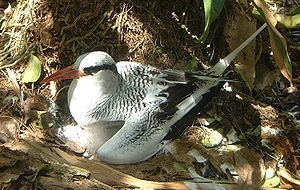
Pelecaniformes
The Pelecaniformes is a order of medium-sized and large waterbirds found worldwide. As traditionally—but erroneously—defined, they encompass all birds that have feet with all four toes webbed. Hence, they were formerly also known by such names as totipalmates or steganopodes...
. Family: Phaethontidae
Tropicbird
Tropicbird
Tropicbirds are a family, Phaethontidae, of tropical pelagic seabirds now classified in their own order Phaethontiformes. Their relationship to other living birds is unclear, and they appear to have no close relatives. There are three species in one genus, Phaethon...
s are slender white birds of tropical oceans, with exceptionally long central tail feathers. Their heads and long wings have black markings. There are 3 species worldwide and 3 species which occur in Chile.
- Red-billed TropicbirdRed-billed TropicbirdThe Red-billed Tropicbird, Phaethon aethereus, also known as the Boatswain Bird is a tropicbird, one of three closely related seabirds of tropical oceans.-Distribution and habitat:...
Phaethon aethereus - Red-tailed TropicbirdRed-tailed TropicbirdThe Red-tailed Tropicbird, Phaethon rubricauda, is a seabird that nests across the Indian and Pacific Oceans. It is the rarest of the tropicbirds, yet is still a widespread bird that is not considered threatened. It nests in colonies on oceanic islands....
Phaethon rubricauda - White-tailed TropicbirdWhite-tailed TropicbirdThe White-tailed Tropicbird Phaethon lepturus, is a tropicbird, smallest of three closely related seabirds of the tropical oceans and smallest member of the order Phaethontiformes. It occurs in the tropical Atlantic, western Pacific and Indian Oceans...
Phaethon lepturus (A)
Pelicans
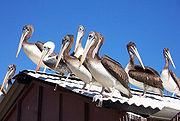
Pelecaniformes
The Pelecaniformes is a order of medium-sized and large waterbirds found worldwide. As traditionally—but erroneously—defined, they encompass all birds that have feet with all four toes webbed. Hence, they were formerly also known by such names as totipalmates or steganopodes...
. Family: Pelecanidae
Pelican
Pelican
A pelican, derived from the Greek word πελεκυς pelekys is a large water bird with a large throat pouch, belonging to the bird family Pelecanidae....
s are large water birds with a distinctive pouch under the beak. As with other members of the order Pelecaniformes, they have webbed feet with four toes. There are 8 species worldwide and 2 species which occur in Chile.
- Peruvian PelicanPeruvian PelicanThe Peruvian Pelican, Pelecanus thagus, is a member of the pelican family. It lives on the west coast of South America, from Lobos de Tierra Island in Peru to Pupuya Islet in Chile....
Pelecanus thagus - Brown PelicanBrown PelicanThe Brown Pelican is the smallest of the eight species of pelican, although it is a large bird in nearly every other regard. It is in length, weighs from and has a wingspan from .-Range and habits:...
Pelecanus occidentalis (A)
Boobies and gannets
Order: PelecaniformesPelecaniformes
The Pelecaniformes is a order of medium-sized and large waterbirds found worldwide. As traditionally—but erroneously—defined, they encompass all birds that have feet with all four toes webbed. Hence, they were formerly also known by such names as totipalmates or steganopodes...
. Family: Sulidae
Sulidae
The bird family Sulidae comprises the gannets and boobies. Collectively called sulidas, they are medium-large coastal seabirds that plunge-dive for fish and similar prey. The ten species in this family are often considered congeneric in older sources, placing all in the genus Sula...
The sulids comprise the gannet
Gannet
Gannets are seabirds comprising the genus Morus, in the family Sulidae, closely related to the boobies.The gannets are large black and white birds with yellow heads. They have long pointed wings and long bills. Northern gannets are the largest seabirds in the North Atlantic, with a wingspan of up...
s and boobies
Booby
A booby is a seabird in the genus Sula, part of the Sulidae family. Boobies are closely related to the gannets , which were formerly included in Sula.-Description:...
. Both groups comprise medium-to-large coastal sea-birds that plunge-dive for fish. There are 9 species worldwide and 5 species which occur in Chile.
- Peruvian BoobyPeruvian BoobyThe Peruvian Booby, Sula variegata, is an endemic bird of the Peruvian current whose distribution is restricted to the west coast of South America from Punta Pariñas in Peru to Concepción in Chile . It is the second most abundant seabird species that inhabits the Peruvian Coast and the second...
Sula variegata - Masked BoobyMasked BoobyThe Masked Booby, Sula dactylatra, is a large seabird of the booby family, Sulidae. This species breeds on islands in tropical oceans, except in the eastern Atlantic; in the eastern Pacific it is replaced by the Nazca Booby, Sula granti, which was formerly regarded as a subspecies of Masked Booby...
Sula dactylatra - Nazca BoobyNazca BoobyThe Nazca Booby, Sula granti, is a booby which is found in the eastern Pacific Ocean, namely on the Galápagos Islands where it can be seen by eco-tourists, and on Clipperton Island...
Sula granti - Red-footed BoobyRed-footed BoobyThe Red-footed Booby, Sula sula, is a large seabird of the booby family, Sulidae. As suggested by the name, adults always have red feet, but the colour of the plumage varies. They are powerful and agile fliers, but they are clumsy in takeoffs and landings...
Sula sula (A) - Brown BoobyBrown BoobyThe Brown Booby is a large seabird of the booby family, Sulidae. The adult brown booby reaches about in length. Its head and upper body are covered in dark brown, with the remainder being a contrasting white. The juvenile form is gray-brown with darkening on the head, wings and tail...
Sula leucogaster
Cormorants
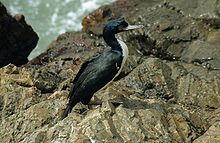
Pelecaniformes
The Pelecaniformes is a order of medium-sized and large waterbirds found worldwide. As traditionally—but erroneously—defined, they encompass all birds that have feet with all four toes webbed. Hence, they were formerly also known by such names as totipalmates or steganopodes...
. Family: Phalacrocoracidae
The Phalacrocoracidae is a family of medium-to-large coastal, fish-eating sea-birds that includes cormorants and shags. Plumage colouration varies with the majority having mainly dark plumage, some species being black and white, and a few being colourful. There are 38 species worldwide and 6 species which occur in Chile.
- Neotropic CormorantNeotropic CormorantThe Neotropic Cormorant or Olivaceous Cormorant is a medium-sized cormorant found throughout the American tropics and subtropics, from the middle Rio Grande and the Gulf and Californian coasts of the USA south through Mexico and Central America to southern South America. It also breeds on the...
Phalacrocorax brasilianus - Rock ShagRock ShagThe Rock Shag , also known as the Magellanic cormorant, is a marine cormorant found around the southernmost coasts of South America. Its breeding range is from around Valdivia, Chile, south to Cape Horn and Tierra del Fuego, and north to Punta Tombo in Argentina...
Phalacrocorax magellanicus - Guanay CormorantGuanay CormorantThe Guanay Cormorant or Guanay Shag is a member of the cormorant family found in on the Pacific coast of Peru and northern Chile...
Phalacrocorax bougainvillii - Antarctic Shag Phalacrocorax bransfieldensis (Ant)
- Imperial ShagImperial ShagThe Imperial Shag, Phalacrocorax atriceps, is a black and white cormorant native to many subantarctic islands, the Antarctic Peninsula and southern South America, primarily in rocky coastal regions, but locally also at large inland lakes. It is sometimes placed in the genus Leucocarbo instead...
Phalacrocorax atriceps - Red-legged CormorantRed-legged CormorantThe Red-legged Cormorant, Phalacrocorax gaimardi, also known as the Red-legged Shag, Red-footed Cormorant, Red-footed Shag, Gaimard’s Cormorant and Grey Cormorant, is a resident of the coastline of South America. It is non-colonial unlike most seabirds. The Red-legged Cormorant has not been...
Phalacrocorax gaimardi
Frigatebirds
Order: PelecaniformesPelecaniformes
The Pelecaniformes is a order of medium-sized and large waterbirds found worldwide. As traditionally—but erroneously—defined, they encompass all birds that have feet with all four toes webbed. Hence, they were formerly also known by such names as totipalmates or steganopodes...
. Family: Fregatidae
Frigatebird
Frigatebird
The frigatebirds are a family, Fregatidae, of seabirds. There are five species in the single genus Fregata. They are also sometimes called Man of War birds or Pirate birds. Since they are related to the pelicans, the term "frigate pelican" is also a name applied to them...
s are large sea-birds usually found over tropical oceans. They are large, black and white or completely black, with long wings and deeply-forked tails. The males have inflatable coloured throat pouches. They do not swim or walk, and cannot take off from a flat surface. Having the largest wingspan to body weight ratio of any bird, they are essentially aerial, able to stay aloft for more than a week. There are 5 species worldwide and 1 species which occurs in Chile.
- Great FrigatebirdGreat FrigatebirdThe Great Frigatebird is a large dispersive seabird in the frigatebird family. Major nesting populations are found in the Pacific and Indian Oceans, as well as a population in the South Atlantic....
Fregata minor
Bitterns, herons and egrets

Ciconiiformes
Traditionally, the order Ciconiiformes has included a variety of large, long-legged wading birds with large bills: storks, herons, egrets, ibises, spoonbills, and several others. Ciconiiformes are known from the Late Eocene...
. Family: Ardeidae
The family Ardeidae contains the bittern
Bittern
Bitterns are a classification of birds in the heron family, Ardeidae, a family of wading birds. Species named bitterns tend to be the shorter-necked, often more secretive members of this family...
s, heron
Heron
The herons are long-legged freshwater and coastal birds in the family Ardeidae. There are 64 recognised species in this family. Some are called "egrets" or "bitterns" instead of "heron"....
s and egret
Egret
An egret is any of several herons, most of which are white or buff, and several of which develop fine plumes during the breeding season. Many egrets are members of the genera Egretta or Ardea which contain other species named as herons rather than egrets...
s. Herons and egrets are medium to large sized wading birds with long necks and legs. Bitterns tend to be shorter necked and more wary. Unlike other long-necked birds such as storks, ibises and spoonbills, members of Ardeidae fly with their necks retracted. There are 61 species worldwide and 10 species which occur in Chile.
- Cocoi HeronCocoi HeronThe Cocoi Heron is a species of heron in the Ardeidae family. It is found in Argentina, Bolivia, Brazil, Chile, Colombia, Ecuador, French Guiana, Guyana, Panama, Paraguay, Peru, Suriname, Uruguay, and Venezuela. It is a non-breeding visitor to Trinidad and Tobago and a vagrant to the Falkland...
Ardea cocoi - Great EgretGreat EgretThe Great Egret , also known as the Great White Egret or Common Egret, White Heron, or Great White Heron, is a large, widely-distributed egret. Distributed across most of the tropical and warmer temperate regions of the world, in southern Europe it is rather localized...
Ardea alba - Tricolored HeronTricolored HeronThe Tricolored Heron formerly known in North America as the Louisiana Heron, is a small heron. It is a resident breeder from the Gulf states of the USA and northern Mexico south through Central America and the Caribbean to central Brazil and Peru...
Egretta tricolor (A) - Little Blue HeronLittle Blue HeronThe Little Blue Heron, Egretta caerulea, is a small heron. It breeds from the Gulf states of the USA through Central America and the Caribbean south to Peru and Uruguay. It is a resident breeder in most of its range, but some northern breeders migrate to the southeastern USA or beyond in winter...
Egretta caerulea - Snowy EgretSnowy EgretThe Snowy Egret is a small white heron. It is the American counterpart to the very similar Old World Little Egret, which has established a foothold in the Bahamas....
Egretta thula - Pacific Reef-Heron Egretta sacra (A)
- Cattle EgretCattle EgretThe Cattle Egret is a cosmopolitan species of heron found in the tropics, subtropics and warm temperate zones. It is the only member of the monotypic genus Bubulcus, although some authorities regard its two subspecies as full species, the Western Cattle Egret and the Eastern Cattle Egret...
Bubulcus ibis - Striated HeronStriated HeronThe Striated Heron, Butorides striata, also known as Mangrove Heron, Little Heron or Green-backed Heron, is a small heron. Striated Herons are mostly non-migratory and noted for some interesting behavioral traits. Their breeding habitat is small wetlands in the Old World tropics from west Africa to...
Butorides striata (A) - Black-crowned Night-Heron Nycticorax nycticorax
- Stripe-backed BitternStripe-backed BitternThe Stripe-backed Bittern is a species of heron in the Ardeidae family.It is found in Argentina, Bolivia, Brazil, Chile, Colombia, French Guiana, Guyana, Paraguay, Peru, Suriname, Trinidad and Tobago, Uruguay, Venezuela, and possibly Ecuador.Its natural habitat is swamps.- References : Database...
Ixobrychus involucris
Storks
Order: CiconiiformesCiconiiformes
Traditionally, the order Ciconiiformes has included a variety of large, long-legged wading birds with large bills: storks, herons, egrets, ibises, spoonbills, and several others. Ciconiiformes are known from the Late Eocene...
. Family: Ciconiidae
Storks are large, long-legged, long-necked, wading birds with long, stout bills. Storks are mute; bill-clattering is an important mode of stork communication at the nest. Their nests can be large and may be reused for many years. Many species are migratory. There are 19 species worldwide and 2 species which occur in Chile.
- Wood StorkWood StorkThe Wood Stork is a large American wading bird in the stork family Ciconiidae. It was formerly called the "Wood Ibis", though it is not really an ibis.-Appearance:...
Mycteria americana (A) - Maguari StorkMaguari StorkThe Maguari Stork is a species of stork in the Ciconiidae family.It is found in Argentina, Bolivia, Brazil, Colombia, French Guiana, Guyana, Paraguay, Suriname, Uruguay, and Venezuela. It is a vagrant to Chile, Trinidad, the Falkland Islands and probably Peru...
Ciconia maguari (A)
Ibises and spoonbills
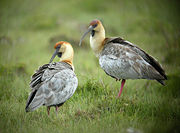
Ciconiiformes
Traditionally, the order Ciconiiformes has included a variety of large, long-legged wading birds with large bills: storks, herons, egrets, ibises, spoonbills, and several others. Ciconiiformes are known from the Late Eocene...
. Family: Threskiornithidae
Threskiornithidae
The family Threskiornithidae includes 34 species of large terrestrial and wading birds, falling into two subfamilies, the ibises and the spoonbills. It was formerly known as Plataleidae. The spoonbills and ibises were once thought to be related to other groups of long-legged wading birds in the...
The Threskiornithidae is a family of large terrestrial and wading birds which includes the ibis
Ibis
The ibises are a group of long-legged wading birds in the family Threskiornithidae....
es and spoonbill
Spoonbill
Spoonbills are a group of large, long-legged wading birds in the family Threskiornithidae, which also includes the Ibises.All have large, flat, spatulate bills and feed by wading through shallow water, sweeping the partly opened bill from side to side...
s. They have long, broad wings with 11 primary and about 20 secondary feathers. They are strong fliers and despite their size and weight, very capable soarers. There are 36 species worldwide and 5 species which occur in Chile.
- Andean Ibis Theristicus branickii
- Black-faced IbisBlack-faced IbisThe Black-faced Ibis is a species of bird in the Threskiornithidae family. It is found in grassland and fields in southern and western South America. It has been included as a subspecies of the similar Buff-necked Ibis, but today all major authorities accept the split...
Theristicus melanopis - White-faced IbisWhite-faced IbisThe White-faced Ibis is a wading bird in the ibis family Threskiornithidae.This species breeds colonially in marshes, usually nesting in bushes or low trees. Its breeding range extends from the western USA south through Mexico, as well as from southeastern Brazil and southeastern Bolivia south to...
Plegadis chihi - Puna IbisPuna IbisThe Puna Ibis is a species of bird in the Threskiornithidae family. It is found in Argentina, Bolivia, Chile, and Peru. Its natural habitat is swamps.-References:* BirdLife International 2004. . Downloaded on 24 July 2007....
Plegadis ridgwayi - Roseate SpoonbillRoseate SpoonbillThe Roseate Spoonbill, Platalea ajaja, is a gregarious wading bird of the ibis and spoonbill family, Threskiornithidae...
Platalea ajaja (A)
Flamingos
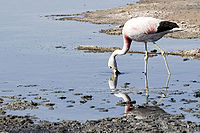
Flamingo
Flamingo
Flamingos or flamingoes are gregarious wading birds in the genus Phoenicopterus , the only genus in the family Phoenicopteridae...
s are gregarious wading birds, usually 3 to 5 feet high, found in both the Western and Eastern Hemispheres. They are more numerous in the latter. Flamingos filter-feed on shellfish and algae. Their oddly-shaped beaks are specially adapted to separate mud and silt from the food they consume, and are uniquely used upside-down. There are 6 species worldwide and 3 species which occur in Chile.
- Chilean FlamingoChilean FlamingoThe Chilean Flamingo is a large species closely related to Caribbean Flamingo and Greater Flamingo, with which it was sometimes considered conspecific...
Phoenicopterus chilensis - Andean FlamingoAndean FlamingoThe Andean flamingo, or Phoenicopterus andinus, is one of the rarest flamingos in the world. It has a pale pink body with brighter upperparts, deep vinaceous-pink lower neck, breast, and wing-coverts. It is the only flamingo species with yellow legs and three-toed feet. The bill of the Andean...
Phoenicopterus andinus - Puna Flamingo Phoenicopterus jamesi
Ducks, geese and swans
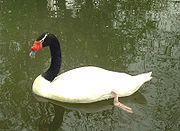
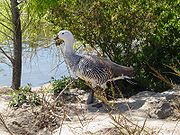
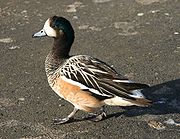
Anseriformes
The order Anseriformes contains about 150 living species of birds in three extant families: the Anhimidae , Anseranatidae , and the Anatidae, which includes over 140 species of waterfowl, among them the ducks, geese, and swans.All species in the order are highly adapted for an aquatic existence at...
. Family: Anatidae
Anatidae
Anatidae is the biological family of birds that includes ducks, geese and swans. The family has a cosmopolitan distribution, occurring on all the world's continents except Antarctica and on most of the world's islands and island groups...
The family Anatidae includes the duck
Duck
Duck is the common name for a large number of species in the Anatidae family of birds, which also includes swans and geese. The ducks are divided among several subfamilies in the Anatidae family; they do not represent a monophyletic group but a form taxon, since swans and geese are not considered...
s and most duck-like waterfowl, such as geese
Goose
The word goose is the English name for a group of waterfowl, belonging to the family Anatidae. This family also includes swans, most of which are larger than true geese, and ducks, which are smaller....
and swan
Swan
Swans, genus Cygnus, are birds of the family Anatidae, which also includes geese and ducks. Swans are grouped with the closely related geese in the subfamily Anserinae where they form the tribe Cygnini. Sometimes, they are considered a distinct subfamily, Cygninae...
s. These are birds that are modified for an aquatic existence with webbed feet, flattened bills and feathers that are excellent at shedding water due to an oily coating. There are 131 species worldwide and 30 species which occur in Chile.
- Fulvous Whistling-Duck Dendrocygna bicolor (A)
- White-faced Whistling-Duck Dendrocygna viduata (A)
- Black-bellied Whistling-Duck Dendrocygna autumnalis (A)
- Black-necked SwanBlack-necked SwanThe Black-necked Swan is the largest waterfowl native to South America. Males are and weigh 4.5-6.7 kg ; females are and weigh 3.5-4.4 kg . The wingspan ranges from . The body plumage is white with a black neck, head and greyish bill. It has a red knob near the base of the bill and...
Cygnus melanocorypha - Coscoroba SwanCoscoroba SwanThe Coscoroba Swan is a species of waterfowl inhabiting southern South America. It is the smallest of the birds called "swans", but still a large species of waterfowl, averaging 4.2 kg , 1 m long and 1.57 m across the wings...
Coscoroba coscoroba - Andean GooseAndean GooseThe Andean Goose, Chloephaga melanoptera, is a member of the duck, goose and swan family Anatidae. It is in the shelduck subfamily Tadorninae.It is resident around lakes and marshes in the high Andes, usually well above 3000 m...
Chloephaga melanoptera - Upland Goose Chloephaga picta
- Kelp GooseKelp GooseThe Kelp Goose , Chloephaga hybrida, is a member of the duck, goose and swan family Anatidae. It is in the shelduck subfamily Tadorninae...
Chloephaga hybrida - Ashy-headed GooseAshy-headed GooseThe Ashy-headed Goose is a large sheldgoose, which breeds in mountainous areas of southernmost South America and winters on lowlands just north of its breeding range....
Chloephaga poliocephala - Ruddy-headed GooseRuddy-headed GooseThe Ruddy-headed Goose is a large sheldgoose, which breeds in southernmost South America.It breeds on open grassy plains in Tierra del Fuego, Chile and the Falkland Islands. The South American birds are now very rare. They winter on lowlands in southern Argentina, some distance north of the...
Chloephaga rubidiceps - Flightless Steamerduck Tachyeres pteneres
- Flying Steamerduck Tachyeres patachonicus
- Muscovy DuckMuscovy DuckThe Muscovy Duck is a large duck which is native to Mexico and Central and South America. A small wild population reaches into the United States in the lower Rio Grande Valley of Texas...
Cairina moschata (I) - Torrent DuckTorrent DuckThe Torrent Duck is a member of the duck, goose and swan family Anatidae. It is the only member of the genus Merganetta. Today it is placed in the shelduck subfamily Tadorninae after the "perching duck" assemblage where it was formerly assigned to was dissolved because it turned out to be...
Merganetta armata - Chiloe WigeonChiloe WigeonThe Chiloe Wigeon is one of three species of wigeon in the dabbling duck genus Anas. Unlike other wigeons, the sexes are similar and pairs are monogamous. This bird has a metallic green head, and a gray bill with a black tip. Its breast is barred black and white and its sides are orange brown...
Anas sibilatrix - Speckled TealSpeckled TealThe Yellow-billed Teal is a South American species of duck. Like other teals, it belongs to the diverse genus Anas; more precisely it is one of the "true" teals of subgenus Nettion. It occurs in Argentina, the Falkland Islands, Chile, Peru, Bolivia, Uruguay, and Brazil...
Anas flavirostris - Spectacled Duck Anas specularis
- Crested DuckCrested DuckThe Crested Duck is a species of duck native to South America, the only member of the monotypic genus Lophonetta. It is sometimes included in Anas, but it belongs to a South American clade that diverged early in dabbling duck evolution . There are two subspecies: L...
Anas specularioides - Yellow-billed PintailYellow-billed PintailThe Yellow-billed Pintail is a South American dabbling duck of the genus Anas with three described subspecies.-Description:...
Anas georgica - White-cheeked PintailWhite-cheeked PintailThe White cheeked Pintail or Bahama Pintail is a dabbling duck of the Caribbean, South America, and the Galápagos Islands....
Anas bahamensis - Puna TealPuna TealThe Puna Teal is a species of dabbling duck in the genus Anas. It was previously regarded as a subspecies of the Silver Teal....
Anas puna - Silver TealSilver TealThe Silver Teal or Versicolor Teal is a species of dabbling duck in the genus Anas. It breeds in South America....
Anas versicolor - Blue-winged TealBlue-winged TealThe Blue-winged Teal is a small dabbling duck from North America.-Description:The Blue-winged Teal is long, with a wingspan of , and a weight of . The adult male has a greyish blue head with a white facial crescent, a light brown body with a white patch near the rear and a black tail. The adult...
Anas discors (A) - Cinnamon TealCinnamon TealThe Cinnamon Teal is a small, reddish dabbling duck found in marshes and ponds of western North and South America.thumb|left|Female Anas cyanoptera septentrionalium...
Anas cyanoptera - Red ShovelerRed ShovelerThe Red Shoveler , formerly known as Red Shoveller, is a species of dabbling duck of the genus Anas. It is found in southern South America, in Argentina, southern Peru, southern Bolivia, Uruguay, Paraguay, the Falkland Islands, South Georgia and South Sandwich Islands, southern Brazil, and Chile...
Anas platalea - Rosy-billed Pochard Netta peposaca
- Southern PochardSouthern PochardThe Southern Pochard is a duck.There are two subspecies, the South American Pochard N. e. erythrophthalma and the African Pochard N. e...
Netta erythrophthalma (A) - Black-headed DuckBlack-headed DuckThe Black-headed Duck is a South American duck allied to the stiff-tailed ducks in the subfamily Oxyurinae of the family Anatidae. It is the only member of the genus Heteronetta....
Heteronetta atricapilla - Andean Duck Oxyura ferruginea
- Lake Duck Oxyura vittata
New World vultures

Falconiformes
The order Falconiformes is a group of about 290 species of birds that comprises the diurnal birds of prey. Raptor classification is difficult and the order is treated in several ways.- Classification problems :...
. Family: Cathartidae
The New World vultures are not closely related to Old World vultures, but superficially resemble them because of convergent evolution
Convergent evolution
Convergent evolution describes the acquisition of the same biological trait in unrelated lineages.The wing is a classic example of convergent evolution in action. Although their last common ancestor did not have wings, both birds and bats do, and are capable of powered flight. The wings are...
. Like the Old World vultures, they are scavengers. However, unlike Old World vultures, which find carcasses by sight, New World vultures have a good sense of smell with which they locate carrion
Carrion
Carrion refers to the carcass of a dead animal. Carrion is an important food source for large carnivores and omnivores in most ecosystems. Examples of carrion-eaters include vultures, hawks, eagles, hyenas, Virginia Opossum, Tasmanian Devils, coyotes, Komodo dragons, and burying beetles...
. There are 7 species worldwide, all of which are found only in the Americas, and 3 species which occur in Chile.
- Black VultureAmerican Black VultureThe Black Vulture also known as the American Black Vulture, is a bird in the New World vulture family whose range extends from the southeastern United States to Central Chile and Uruguay in South America...
Coragyps atratus - Turkey VultureTurkey VultureThe Turkey Vulture is a bird found throughout most of the Americas. It is also known in some North American regions as the Turkey Buzzard , and in some areas of the Caribbean as the John Crow or Carrion Crow...
Cathartes aura - Andean CondorAndean CondorThe Andean Condor is a species of South American bird in the New World vulture family Cathartidae and is the only member of the genus Vultur...
Vultur gryphus
Osprey
Order: FalconiformesFalconiformes
The order Falconiformes is a group of about 290 species of birds that comprises the diurnal birds of prey. Raptor classification is difficult and the order is treated in several ways.- Classification problems :...
. Family: Pandionidae
The Pandionidae family contains only one species, the Osprey. The Osprey is a medium large raptor
Bird of prey
Birds of prey are birds that hunt for food primarily on the wing, using their keen senses, especially vision. They are defined as birds that primarily hunt vertebrates, including other birds. Their talons and beaks tend to be relatively large, powerful and adapted for tearing and/or piercing flesh....
which is a specialist fish-eater with a worldwide distribution.
- OspreyOspreyThe Osprey , sometimes known as the sea hawk or fish eagle, is a diurnal, fish-eating bird of prey. It is a large raptor, reaching more than in length and across the wings...
Pandion haliaetus
Hawks, kites and eagles
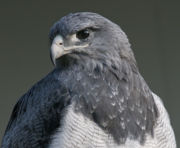
Falconiformes
The order Falconiformes is a group of about 290 species of birds that comprises the diurnal birds of prey. Raptor classification is difficult and the order is treated in several ways.- Classification problems :...
. Family: Accipitridae
Accipitridae
The Accipitridae, one of the two major families within the order Accipitriformes , are a family of small to large birds with strongly hooked bills and variable morphology based on diet. They feed on a range of prey items from insects to medium-sized mammals, with a number feeding on carrion and a...
Accipitridae is a family of birds of prey and include hawk
Hawk
The term hawk can be used in several ways:* In strict usage in Australia and Africa, to mean any of the species in the subfamily Accipitrinae, which comprises the genera Accipiter, Micronisus, Melierax, Urotriorchis and Megatriorchis. The large and widespread Accipiter genus includes goshawks,...
s, eagle
Eagle
Eagles are members of the bird family Accipitridae, and belong to several genera which are not necessarily closely related to each other. Most of the more than 60 species occur in Eurasia and Africa. Outside this area, just two species can be found in the United States and Canada, nine more in...
s, kites
Kite (bird)
Kites are raptors with long wings and weak legs which spend a great deal of time soaring. Most feed mainly on carrion but some take various amounts of live prey.They are birds of prey which, along with hawks and eagles, are from the family Accipitridae....
, harriers
Harrier (bird)
A harrier is any of the several species of diurnal hawks forming the Circinae sub-family of the Accipitridae family of birds of prey. Harriers characteristically hunt by flying low over open ground, feeding on small mammals, reptiles, or birds....
and Old World vultures. These birds have powerful hooked beaks for tearing flesh from their prey, strong legs, powerful talons, and keen eyesight. There are 233 species worldwide and 13 species which occur in Chile.
- White-tailed KiteWhite-tailed KiteThe White-tailed Kite is an elanid kite of genus Elanus found in western North America and parts of South America.Their coloration is gull-like, but their shape and flight falcon-like, with a rounded tail...
Elanus leucurus - Long-winged HarrierLong-winged HarrierThe Long-winged Harrier is a species of bird of prey in the family Accipitridae, native to South America.It is found in Argentina, Bolivia, Brazil, Chile, Colombia, Falkland Islands, French Guiana, Guyana, Paraguay, Suriname, Trinidad and Tobago, Uruguay, and Venezuela.Its natural habitats are dry...
Circus buffoni (A) - Cinereous HarrierCinereous HarrierThe Cinereous Harrier is a South American bird of prey of the harrier family. Its breeding range extends from the Tierra del Fuego through Argentina and Chile to Bolivia, Paraguay and southern Brasil; and across the Andes north to Colombia.The term cinereous describes its colouration...
Circus cinereus - Chilean HawkChilean HawkThe Chilean Hawk is a bird of prey species belonging to the typical hawks. It breeds in Andes forests from central Chile and western Argentina south to Tierra del Fuego, from sea level to 2,700 m altitude...
Accipiter chilensis - Harris's HawkHarris's HawkThe Harris's Hawk or Harris Hawk formerly known as the Bay-winged Hawk or Dusky Hawk, is a medium-large bird of prey which breeds from the southwestern United States south to Chile and central Argentina...
Parabuteo unicinctus - Black-chested Buzzard-EagleBlack-chested Buzzard-eagleThe Black-chested Buzzard-Eagle is a bird of prey of the hawk and eagle family . It lives in open regions of South America. This species is also known as the Black Buzzard-eagle, Grey Buzzard-eagle or analogously with "eagle" or "eagle-buzzard" replacing "buzzard-eagle", or as the Chilean Blue Eagle...
Geranoaetus melanoleucus - Roadside HawkRoadside HawkThe Roadside Hawk is a relatively small bird of prey found in Latin America. This vocal species is often the most common raptor in its range. It has many subspecies and is sometimes placed in the monotypic genus Rupornis instead of Buteo.-Description:The Roadside Hawk is long and weighs...
Buteo magnirostris (A) - White-throated HawkWhite-throated HawkThe White-throated Hawk, Buteo albigula, is a bird of prey in the family Accipitridae, which includes the eagles, hawks and Old World vultures. In British usage it would be called a buzzard rather than a true hawk....
Buteo albigula - Swainson's HawkSwainson's HawkThe Swainson's Hawk , is a large buteo hawk of the Falconiformes, sometimes separated in the Accipitriformes like its relatives. This species was named after William Swainson, a British naturalist...
Buteo swainsoni (A) - Red-backed Hawk Buteo polyosoma
- Puna Hawk Buteo poecilochrous (A)
- Rufous-tailed HawkRufous-tailed HawkThe Rufous-tailed Hawk is a species of bird of prey in the Accipitridae family.The Rufous-tailed Hawk is found in southern Argentina and Chile, including the entire region of Tierra del Fuego....
Buteo ventralis - Golden EagleGolden EagleThe Golden Eagle is one of the best known birds of prey in the Northern Hemisphere. Like all eagles, it belongs to the family Accipitridae. Once widespread across the Holarctic, it has disappeared from many of the more heavily populated areas...
Aquila chrysaetos
Caracaras and falcons
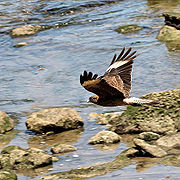
Falconiformes
The order Falconiformes is a group of about 290 species of birds that comprises the diurnal birds of prey. Raptor classification is difficult and the order is treated in several ways.- Classification problems :...
. Family: Falconidae
Falconidae
The falcons and caracaras are around 60 species of diurnal birds of prey that make up the family Falconidae. The family is divided into two subfamiles, Polyborinae, which includes the caracaras and forest falcons, and Falconinae, the falcons, kestrels and falconets.-Description:Falcons and...
Falconidae is a family of diurnal birds of prey. They differ from hawks, eagles, and kites in that they kill with their beaks instead of their feet. There are 62 species worldwide and 10 species which occur in Chile.
- Mountain CaracaraMountain CaracaraThe Mountain Caracara is a species of bird of prey in the Falconidae family. It is found in puna and páramo in the Andes, ranging from southern Ecuador, through Peru and Bolivia, to northern Argentina and Chile. It is generally uncommon to fairly common...
Phalcoboenus megalopterus - White-throated CaracaraWhite-throated CaracaraThe White-throated Caracara is a species of bird of prey in the Falconidae family. It is found in grasslands and other barren habitats in the Andes of southern Chile and Argentina. It is generally uncommon to fairly common...
Phalcoboenus albogularis - Striated CaracaraStriated CaracaraThe Striated Caracara, is a bird of prey of the Falconidae family. In the Falkland Islands it is known as the Johnny Rook.-Description:...
Phalcoboenus australis - Southern CaracaraSouthern CaracaraThe Southern Crested Caracara , also known as the Southern Caracara, is a bird of prey in the family Falconidae. It formerly included the Northern Caracara of the southern United States, Mexico, Central America and northern South America, and the extinct Guadalupe Caracara as subspecies...
Caracara plancus - Chimango CaracaraChimango CaracaraThe Chimango Caracara also known as Tiuque is a species of bird of prey in the Falconidae family.It is found in Argentina, Brazil, Chile, Paraguay and Uruguay. It is a vagrant to the Falkland Islands...
Milvago chimango - Laughing FalconLaughing FalconThe Laughing Falcon , also called the Snake Hawk , is a medium-sized bird of prey in the falcon family , the only member of the genus Herpetotheres. This Neotropical species is a specialist snake-eater...
Herpetotheres cachinnans (A) - American KestrelAmerican KestrelThe American Kestrel , sometimes colloquially known as the Sparrow Hawk, is a small falcon, and the only kestrel found in the Americas. It is the most common falcon in North America, and is found in a wide variety of habitats. At long, it is also the smallest falcon in North America...
Falco sparverius - Aplomado FalconAplomado FalconThe Aplomado Falcon, Falco femoralis, is a medium-sized falcon of the Americas. The species' largest contiguous range is in South America, but not in the deep interior Amazon Basin. It was long known as Falco fusco-coerulescens or Falco fuscocaerulescens, but these names are now believed to refer...
Falco femoralis - Orange-breasted FalconOrange-breasted FalconThe Orange-breasted Falcon is a bird of the falcon family. It is probably closely related to and looks like a larger version of the Bat Falcon. These two, in turn, are probably closest to the Aplomado Falcon and constitute a rather old American lineage of Falcos.It is found from southern Mexico to...
Falco deiroleucus (A) - Peregrine FalconPeregrine FalconThe Peregrine Falcon , also known as the Peregrine, and historically as the Duck Hawk in North America, is a widespread bird of prey in the family Falconidae. A large, crow-sized falcon, it has a blue-gray back, barred white underparts, and a black head and "moustache"...
Falco peregrinus
New World quails
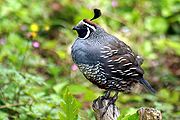
Galliformes
Galliformes are an order of heavy-bodied ground-feeding domestic or game bird, containing turkey, grouse, chicken, New and Old World Quail, ptarmigan, partridge, pheasant, and the Cracidae. Common names are gamefowl or gamebirds, landfowl, gallinaceous birds or galliforms...
. Family: Odontophoridae
The New World quail
New World quail
The New World quails or Odontophorids are small birds only distantly related to the Old World Quails, but named for their similar appearance and habits. The American species are in their own family Odontophoridae, whereas Old World Quail are in the pheasant family Phasianidae...
s are small, plump terrestrial birds only distantly related to the quails of the Old World, but named for their similar appearance and habits. There are 32 species worldwide, all found only in the Americas, and 1 species which occurs in Chile.
- California QuailCalifornia QuailThe California Quail, Callipepla californica, also known as the California Valley Quail or Valley Quail, is a small ground-dwelling bird in the New World quail family...
Callipepla californica (I)
Pheasants and partridges
Order: GalliformesGalliformes
Galliformes are an order of heavy-bodied ground-feeding domestic or game bird, containing turkey, grouse, chicken, New and Old World Quail, ptarmigan, partridge, pheasant, and the Cracidae. Common names are gamefowl or gamebirds, landfowl, gallinaceous birds or galliforms...
. Family: Phasianidae
Phasianidae
The Phasianidae is a family of birds which consists of the pheasants and partridges, including the junglefowl , Old World Quail, francolins, monals and peafowl. The family is a large one, and is occasionally broken up into two subfamilies, the Phasianinae, and the Perdicinae...
The Phasianidae are a family of terrestrial birds which consists of quail
Quail
Quail is a collective name for several genera of mid-sized birds generally considered in the order Galliformes. Old World quail are found in the family Phasianidae, while New World quail are found in the family Odontophoridae...
s, partridge
Partridge
Partridges are birds in the pheasant family, Phasianidae. They are a non-migratory Old World group.These are medium-sized birds, intermediate between the larger pheasants and the smaller quails. Partridges are native to Europe, Asia, Africa, and the Middle East...
s, snowcock
Snowcock
The snowcocks are a group of bird species in the genus Tetraogallus of the pheasant family, Phasianidae. They are ground-nesting birds which breed in the mountain ranges of southern Eurasia from the Caucasus to the Himalayas and western China. The Himalayan Snowcock has been introduced...
s, francolin
Francolin
Francolins are birds that traditionally have been placed in the genus Francolinus, but now commonly are divided into multiple genera , although some of the major taxonomic listing sources have yet to divide them. They are members of the pheasant family, Phasianidae...
s, spurfowls, tragopan
Tragopan
Tragopan is a genus of bird in the family Phasianidae. These birds are commonly called "horny pheasants" because of two brightly-colored, fleshy horns on their heads that they can erect during courtship displays...
s, monal
Monal
A Monal is a bird of genus Lophophorus of the Pheasant family, Phasianidae. There are three species and several sub-species within the genus Lophophorus:* Himalayan Monal Lophophorus impejanus* Sclater's Monal Lophophorus sclateri...
s, pheasant
Pheasant
Pheasants refer to some members of the Phasianinae subfamily of Phasianidae in the order Galliformes.Pheasants are characterised by strong sexual dimorphism, males being highly ornate with bright colours and adornments such as wattles and long tails. Males are usually larger than females and have...
s, peafowl
Peafowl
Peafowl are two Asiatic species of flying birds in the genus Pavo of the pheasant family, Phasianidae, best known for the male's extravagant eye-spotted tail, which it displays as part of courtship. The male is called a peacock, the female a peahen, and the offspring peachicks. The adult female...
s and jungle fowls. In general, they are plump (although they may vary in size) and have broad, relatively short wings. There are 156 species worldwide and 1 species which occurs in Chile.
- Ring-necked Pheasant Phasianus colchicus (I)
Rails, crakes, gallinules, and coots


Gruiformes
The Gruiformes are an order containing a considerable number of living and extinct bird families, with a widespread geographical diversity. Gruiform means "crane-like"....
. Family: Rallidae
Rallidae
The rails, or Rallidae, are a large cosmopolitan family of small to medium-sized birds. The family exhibits considerable diversity and the family also includes the crakes, coots, and gallinules...
Rallidae is a large family of small to medium-sized birds which includes the rails, crakes, coot
Coot
Coots are medium-sized water birds that are members of the rail family Rallidae. They constitute the genus Fulica. Coots have predominantly black plumage, and, unlike many of the rails, they are usually easy to see, often swimming in open water...
s, and gallinule
Rallidae
The rails, or Rallidae, are a large cosmopolitan family of small to medium-sized birds. The family exhibits considerable diversity and the family also includes the crakes, coots, and gallinules...
s. Typically they inhabit dense vegetation in damp environments near lakes, swamps, or rivers. In general they are shy and secretive birds, difficult to observe. Most species have strong legs, and have long toes which are well adapted to soft, uneven surfaces. They tend to have short, rounded wings and be weak fliers. There are 143 species worldwide and 13 species which occur in Chile.
- Black RailBlack RailThe Black Rail is a mouse-sized member of the Rallidae family of birds. It is found in scattered parts of North America and the Pacific region of South America, usually in coastal salt marshes but also in some freshwater marshes. It is extinct or threatened in many locations due to habitat loss...
Laterallus jamaicensis - Austral RailAustral RailThe Austral Rail is a species of bird in the Rallidae family.It is found in Argentina and Chile.Its natural habitats are swamps, freshwater lakes, and freshwater marshes.It is threatened by habitat loss.-References:...
Rallus antarcticus - Spotted RailSpotted RailThe Spotted Rail is a species of bird in the Rallidae family.It is found in Argentina, Belize, Bolivia, Brazil, Cayman Islands, Chile, Colombia, Costa Rica, Cuba, the Dominican Republic, Ecuador, El Salvador, French Guiana, Guyana, Haiti, Jamaica, Mexico, Panama, Paraguay, Peru, Suriname, Trinidad...
Pardirallus maculatus (A) - Plumbeous RailPlumbeous RailThe Plumbeous Rail is a species of bird in the Rallidae family.It is found in Argentina, Bolivia, Brazil, Chile, Ecuador, Paraguay, Peru and Uruguay, and is a vagrant to the Falkland Islands.Its natural habitat is swamps....
Pardirallus sanguinolentus - Purple GallinuleAmerican Purple GallinuleThe American Purple Gallinule is a "swamp hen" in the rail family Rallidae.A medium-sized rail with big yellow feet, purple-blue plumage with a green back, and red and yellow bill. It has a pale blue forehead shield and white undertail.Juveniles are brown overall with a brownish olive back...
Porphyrio martinica (A) - Common MoorhenCommon MoorhenThe Common Moorhen is a bird in the Rallidae family with an almost worldwide distribution. The North and South American Committees of the AOU and the IOC have voted on or before July 2011 to split the American forms into a new species Common Gallinule, however, no other committee has voted to...
Gallinula chloropus - Spot-flanked GallinuleSpot-flanked GallinuleThe Spot-flanked Gallinule is a species of bird in the Rallidae family.It is found in Argentina, Bolivia, Brazil, Chile, Colombia, Paraguay, Peru, and Uruguay.Its natural habitats are swamps and freshwater lakes....
Gallinula melanops - White-winged CootWhite-winged CootThe White-winged Coot is a species of bird in the Rallidae family. At in length, it is a mid-sized coot. It is found in swamps and at lakes in southern South America, including the Falkland Islands, ranging as far north as Bolivia and southern Brazil...
Fulica leucoptera - Slate-colored Coot Fulica ardesiaca
- Red-gartered CootRed-gartered CootThe Red-gartered Coot is a species of bird in the Rallidae family. At in length, it is a fairly large species of coot....
Fulica armillata - Red-fronted CootRed-fronted CootThe Red-fronted Coot is a species of bird in the Rallidae family. At , it is a mid-sized species of coot.It is found in Argentina, southern Brazil, Chile, Paraguay, southern Peru and Uruguay. There are also records from Bolivia and the Falkland Islands.Its natural habitat is swamps and...
Fulica rufifrons - Giant CootGiant CootThe Giant Coot is a species of bird found at lakes in the altiplano from central Peru, through western Bolivia, to north-eastern Chile and extreme north-western Argentina. With a total length of 48–64 cm , it is the second largest extant member of the Rallidae family, after the Takahe, and...
Fulica gigantea - Horned CootHorned CootThe Horned Coot is a species of bird found at lakes in the altiplano of north-western Argentina, south-western Bolivia, and north-eastern Chile. It is almost entirely restricted to altitudes of 3000-5200 m.a.s.l., but has occasionally been recorded at lower altitudes...
Fulica cornuta
Jacanas
Order: CharadriiformesCharadriiformes
Charadriiformes is a diverse order of small to medium-large birds. It includes about 350 species and has members in all parts of the world. Most Charadriiformes live near water and eat invertebrates or other small animals; however, some are pelagic , some occupy deserts and a few are found in thick...
. Family: Jacanidae
The jacana
Jacana
The jaçanas are a group of tropical waders in the family Jacanidae. They are found worldwide within the tropical zone. See Etymology below for pronunciation....
s are a group of tropical waders in the family Jacanidae. They are found worldwide in the Tropics. They are identifiable by their huge feet and claws which enable them to walk on floating vegetation in the shallow lakes that are their preferred habitat. There 8 species worldwide and 1 species which occurs in Chile.
- Wattled JacanaWattled JacanaThe Wattled Jacana Jacana jacana is a wader which is a resident breeder from western Panama and Trinidad south through most of South America east of the Andes....
Jacana jacana (A)
Painted snipe
Order: CharadriiformesCharadriiformes
Charadriiformes is a diverse order of small to medium-large birds. It includes about 350 species and has members in all parts of the world. Most Charadriiformes live near water and eat invertebrates or other small animals; however, some are pelagic , some occupy deserts and a few are found in thick...
. Family: Rostratulidae
Painted snipe are short-legged, long-billed birds similar in shape to the true snipes, but more brightly coloured. There are 2 species worldwide and 1 species which occurs in Chile.
- American Painted-snipe Rostratula semicollaris
Oystercatchers

Charadriiformes
Charadriiformes is a diverse order of small to medium-large birds. It includes about 350 species and has members in all parts of the world. Most Charadriiformes live near water and eat invertebrates or other small animals; however, some are pelagic , some occupy deserts and a few are found in thick...
. Family: Haematopodidae
The oystercatcher
Oystercatcher
The oystercatchers are a group of waders; they form the family Haematopodidae, which has a single genus, Haematopus. They are found on coasts worldwide apart from the polar regions and some tropical regions of Africa and South East Asia...
s are large and noisy plover
Plover
Plovers are a widely distributed group of wading birds belonging to the subfamily Charadriinae. There are about 40 species in the subfamily, most of them called "plover" or "dotterel". The closely related lapwing subfamily, Vanellinae, comprises another 20-odd species.Plovers are found throughout...
-like birds, with strong bills used for smashing or prising open molluscs. There are 11 species worldwide and 3 species which occur in Chile.
- Magellanic OystercatcherMagellanic OystercatcherThe Magellanic Oystercatcher is a species of wader in the Haematopodidae family.It is found in Argentina, Chile and the Falkland Islands.Its natural habitats are freshwater lakes and sandy shores.-References:...
Haematopus leucopodus - Blackish OystercatcherBlackish OystercatcherThe Blackish Oystercatcher is a species of wader in the Haematopodidae family.It is found in Argentina, Chile, the Falkland Islands and Peru, and is a vagrant to Uruguay.The population is estimated at 22,000–120,000....
Haematopus ater - American OystercatcherAmerican OystercatcherThe American Oystercatcher , occasionally called the American Pied Oystercatcher, is a member of family Haematopodidae. The bird is marked by its black and white body and a long, thick orange beak...
Haematopus palliatus
Avocets and stilts
Order: CharadriiformesCharadriiformes
Charadriiformes is a diverse order of small to medium-large birds. It includes about 350 species and has members in all parts of the world. Most Charadriiformes live near water and eat invertebrates or other small animals; however, some are pelagic , some occupy deserts and a few are found in thick...
. Family: Recurvirostridae
Recurvirostridae
Recurvirostridae is a family of birds in the wader suborder Charadrii. It contains two distinct groups of birds, the avocets and the stilts .-Description and diet:...
Recurvirostridae is a family of large wading birds, which includes the avocet
Avocet
The four species of Avocets are a genus, Recurvirostra, of waders in the same avian family as the stilts.Avocets have long legs and long, thin, upcurved bills which they sweep from side to side when feeding in the brackish or saline wetlands they prefer...
s and the stilt
Stilt
Stilt is a common name for several species of birds in the family Recurvirostridae, which also includes those known as avocets. They are found in brackish or saline wetlands in warm or hot climates....
s. The avocets have long legs and long up-curved bills. The stilts have extremely long legs and long, thin, straight bills. There are 9 species worldwide and 2 species which occur in Chile.
- White-backed Stilt Himantopus melanurus
- Andean AvocetAndean AvocetThe Andean Avocet is a large wader in the avocet and stilt bird family, Recurvirostridae. It is resident in the Andes, breeding above 3500 m in northwestern Argentina, western Bolivia, northern Chile and southern Peru.-Description:...
Recurvirostra andina
Thick-knees
Order: CharadriiformesCharadriiformes
Charadriiformes is a diverse order of small to medium-large birds. It includes about 350 species and has members in all parts of the world. Most Charadriiformes live near water and eat invertebrates or other small animals; however, some are pelagic , some occupy deserts and a few are found in thick...
. Family: Burhinidae
The thick-knees are a group of largely tropical waders in the family Burhinidae. They are found worldwide within the tropical zone, with some species also breeding in temperate Europe and Australia. They are medium to large waders with strong black or yellow black bills, large yellow eyes and cryptic plumage. Despite being classed as waders, most species have a preference for arid or semi-arid habitats. There are 9 species worldwide and 1 species which occurs in Chile.
- Peruvian Thick-kneePeruvian Thick-kneeThe Peruvian Thick-knee is a species of bird in the Burhinidae family.It is found in Chile, Ecuador, and Peru....
Burhinus superciliaris
Plovers and lapwings

Charadriiformes
Charadriiformes is a diverse order of small to medium-large birds. It includes about 350 species and has members in all parts of the world. Most Charadriiformes live near water and eat invertebrates or other small animals; however, some are pelagic , some occupy deserts and a few are found in thick...
. Family: Charadriidae
Charadriidae
The bird family Charadriidae includes the plovers, dotterels, and lapwings, about 64 to 66 species in all.- Morphology :They are small to medium-sized birds with compact bodies, short, thick necks and long, usually pointed, wings, but most species of lapwing may have more rounded wings...
The family Charadriidae includes the plover
Plover
Plovers are a widely distributed group of wading birds belonging to the subfamily Charadriinae. There are about 40 species in the subfamily, most of them called "plover" or "dotterel". The closely related lapwing subfamily, Vanellinae, comprises another 20-odd species.Plovers are found throughout...
s, dotterels, and lapwing
Lapwing
Vanellinae are any of various crested plovers, family Charadriidae, noted for its slow, irregular wingbeat in flight and a shrill, wailing cry. Its length is 10-16 inches. They are a subfamily of medium-sized wading birds which also includes the plovers and dotterels. The Vanellinae are...
s. They are small to medium-sized birds with compact bodies, short, thick necks and long, usually pointed, wings. They are found in open country worldwide, mostly in habitats near water, although there are some exceptions. There are 66 species worldwide and 14 species which occur in Chile.
- Southern LapwingSouthern LapwingThe Southern Lapwing is a wader in the family Charadriiformes. It is a common and widespread resident throughout South America, except in densely forested regions , the higher parts of the Andes and the arid coast of a large part of western South America. This bird is particularly common in the...
Vanellus chilensis - Andean LapwingAndean LapwingThe Andean Lapwing is a species of bird in the Charadriidae family.It is found in Argentina, Bolivia, Chile, Colombia, Ecuador, and Peru....
Vanellus resplendens - American Golden-Plover Pluvialis dominica
- Black-bellied Plover Pluvialis squatarola
- Semipalmated PloverSemipalmated PloverThe Semipalmated Plover is a small plover.This species weighs and measures in length and across the wings. Adults have a grey-brown back and wings, a white belly, and a white breast with one black neckband...
Charadrius semipalmatus - Wilson's PloverWilson's PloverThe Wilson's Plover is a small plover.Wilson's Plover is a coastal wader which breeds on both coasts of the Americas from the equator northwards. Its range extends north to include much of the U.S. eastern seaboard, and the Pacific coast of Mexico on the west.It is a partial migrant. Birds leave...
Charadrius wilsonia (A) - KilldeerKilldeerThe Killdeer is a medium-sized plover.Adults have a brown back and wings, a white belly, and a white breast with two black bands. The rump is tawny orange. The face and cap are brown with a white forehead. They have an orange-red eyering...
Charadrius vociferus - Snowy PloverSnowy PloverThe Snowy Plover is a small wader in the plover bird family. It breeds in Ecuador, Peru, Chile, the southern and western USA and the Caribbean...
Charadrius alexandrinus - Collared PloverCollared PloverThe Collared Plover, Charadrius collaris, is a small shorebird in the plover family, Charadriidae. It lives along coasts and riverbanks of the tropical to temperate Americas, from central Mexico south to Chile and Argentina....
Charadrius collaris - Puna PloverPuna PloverThe Puna Plover is a species of bird in the Charadriidae family.It is found in Argentina, Bolivia, Chile, and Peru.Its natural habitats are freshwater lakes and saline marshes.-References:...
Charadrius alticola - Two-banded PloverTwo-banded PloverThe Two-banded Plover is a species of bird in the Charadriidae family.It breeds in Argentina, Chile and the Falkland Islands...
Charadrius falklandicus - Rufous-chested Dotterel Charadrius modestus
- Diademed Sandpiper-PloverDiademed Sandpiper-ploverThe Diademed Plover or Diademed Sandpiper-Plover is a species of bird in the Charadriidae family. It is monotypic within the genus Phegornis.It is found in Argentina, Bolivia, Chile, and Peru....
Phegornis mitchellii - Tawny-throated DotterelTawny-throated DotterelThe Tawny-throated Dotterel is a species of bird in the Charadriidae family. It is placed in the genus Oreopholus, which is monotypic as regards living species. A prehistoric relative, Oreopholus orcesi, has been described from fossil remains.It breeds in the Andes in Argentina, Bolivia, Chile...
Oreopholus ruficollis
Magellanic Plover
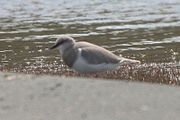
Charadriiformes
Charadriiformes is a diverse order of small to medium-large birds. It includes about 350 species and has members in all parts of the world. Most Charadriiformes live near water and eat invertebrates or other small animals; however, some are pelagic , some occupy deserts and a few are found in thick...
. Family: Pluvianellidae
The Magellanic Plover is a rare wader found only in southernmost South America. In its build and habits it is similar to a turnstone
Turnstone
Turnstones are the bird species in the genus Arenaria in the family Scolopacidae. They are closely related to calidrid sandpipers and might be considered members of the tribe Calidriini....
. Its upperparts and breast are pale grey, and the rest of the underparts are white. It has short red legs, a black bill and a red eye. In young birds, the eyes and legs are yellowish in colour.
- Magellanic PloverMagellanic PloverThe Magellanic Plover is a rare and unique wader found only in southernmost South America. It was long placed in with the other plovers in the family Charadriidae, however behavioural evidence suggested they were distinct, and molecular studies confirmed this, suggesting that they are actually...
Pluvianellus socialis
Sandpipers and allies
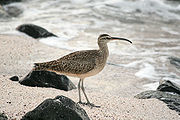


Charadriiformes
Charadriiformes is a diverse order of small to medium-large birds. It includes about 350 species and has members in all parts of the world. Most Charadriiformes live near water and eat invertebrates or other small animals; however, some are pelagic , some occupy deserts and a few are found in thick...
. Family: Scolopacidae
Scolopacidae
The sandpipers are a large family, Scolopacidae, of waders or shorebirds. They include many species called sandpipers, as well as those called by names such as curlew and snipe. The majority of these species eat small invertebrates picked out of the mud or soil...
The Scolopacidae are a large diverse family of small to medium sized shorebirds including the sandpipers, curlew
Curlew
The curlews , genus Numenius, are a group of eight species of birds, characterised by long, slender, downcurved bills and mottled brown plumage. They are one of the most ancient lineages of scolopacid waders, together with the godwits which look similar but have straight bills...
s, godwit
Godwit
The godwits are a group of large, long-billed, long-legged and strongly migratory wading birds of the genus Limosa. They form large flocks on coasts and estuaries in winter....
s, shanks
Tringa
Tringa is a genus of waders, containing the shanks and tattlers. They are mainly freshwater birds, often with brightly coloured legs as reflected in the English names of six species, as well as the specific names of two of these and the Green Sandpiper. They are typically associated with northern...
, tattler
Tattler (bird)
The tattlers are the two very similar bird species in the shorebird genus Tringa. They formerly had their own genus, Heteroscelus. The old genus name means "different leg" in Greek, referring to the leg scales that differentiate the tattlers from their close relatives, the shanks.The species are:*...
s, woodcock
Woodcock
The woodcocks are a group of seven or eight very similar living species of wading birds in the genus Scolopax. Only two woodcocks are widespread, the others being localized island endemics. Most are found in the Northern Hemisphere but a few range into Wallacea...
s, snipe
Snipe
A snipe is any of about 25 wading bird species in three genera in the family Scolopacidae. They are characterized by a very long, slender bill and crypsis plumage. The Gallinago snipes have a nearly worldwide distribution, the Lymnocryptes Jack Snipe is restricted to Asia and Europe and the...
s, dowitcher
Dowitcher
The three dowitchers are medium-sized long-billed wading birds. They resemble godwits in body and bill shape, and the reddish underparts in summer, but are much shorter legged, more like snipe to which they are also somewhat closer related...
s and phalarope
Phalarope
A phalarope or wadepiper is any of three living species of slender-necked shorebirds in the genus Phalaropus of the bird family Scolopacidae. They are close relatives of the shanks and tattlers, the Actitis and Terek Sandpipers, and also of the turnstones and calidrids...
s. The majority of species eat small invertebrates picked out of the mud or soil. Variation in length of legs and bills enable different species to feed in the same habitat, particularly on the coast, without direct competition for food. There are 89 species worldwide and 31 species which occur in Chile.
- South American SnipeSouth American SnipeThe South American Snipe or Magellan Snipe, Gallinago paraguaiae, is a small, stocky wader. Its taxonomic position is complicated, sometimes treated as a race of Common Snipe...
Gallinago paraguaiae - Puna SnipePuna SnipeThe Puna Snipe, Gallinago andina, is a small, stocky wader. It breeds in the Andes of northern Peru to northwestern Argentina and northern Chile. It is sometimes considered conspecific with the South American Snipe.-Description:...
Gallinago andina - Fuegian SnipeFuegian SnipeThe Fuegian Snipe, Gallinago stricklandii, also known as the Cordilleran Snipe, is a small stocky wader. It breeds in south-central Chile and Argentina south to Tierra del Fuego. It is mainly sedentary, but the Tierra del Fuego population winters in mainland Chile.It is sporadically recorded in...
Gallinago stricklandii - Short-billed DowitcherShort-billed DowitcherThe Short-billed Dowitcher like its congener the Long-billed Dowitcher, is a medium-sized, stocky, long-billed shorebird in the family Scolopacidae. It is an inhabitant of North America, Middle America, and northern South America. It is strongly migratory; it completely vacates in breeding areas...
Limnodromus griseus (A) - Hudsonian GodwitHudsonian GodwitThe Hudsonian Godwit, Limosa haemastica, is a large shorebird.-Identification:Adults have long dark legs and a long pink bill with a slight upward curve and dark at the tip. The upper parts are mottled brown and the underparts are chestnut. The tail is black and the rump is white...
Limosa haemastica - Marbled GodwitMarbled GodwitThe Marbled Godwit, Limosa fedoa, is a large shorebird. On average, it is the largest of the 4 species of godwit. The total length is , including a large bill of , and wingspan is . Body mass can vary from ....
Limosa fedoa (A) - Eskimo CurlewEskimo CurlewThe Eskimo or the "Northern Curlew" is a critically endangered shorebird, now considered by many to be extinct.-Taxonomy:The Eskimo Curlew is one of eight species of curlew, and is classed with them in the genus Numenius. It was formerly placed in the separate genus Mesoscolopax. Numenius is...
Numenius borealis (A) - WhimbrelWhimbrelThe Whimbrel Numenius phaeopus, is a wader in the large family Scolopacidae. It is one of the mostwidespread of the curlews, breeding across much of subarctic North America, Europe and Asia as far south as Scotland....
Numenius phaeopus - Bristle-thighed CurlewBristle-thighed CurlewThe Bristle-thighed Curlew, Numenius tahitiensis, is a large shorebird that breeds in Alaska and winters on tropical Pacific islands. It has a long, decurved bill and bristled feathers at the base of the legs. Its length is about 43 cm and wingspan about 84 cm...
Numenius tahitiensis (A) - Upland SandpiperUpland SandpiperThe Upland Sandpiper is a large shorebird, closely related to the curlews . Older names are the Upland Plover and Bartram's Sandpiper. It is the only member of the genus Bartramia. The genus name and the old common name Bartram's Sandpiper commemorate the American naturalist William Bartram...
Bartramia longicauda (A) - Greater YellowlegsGreater YellowlegsThe Greater Yellowlegs, Tringa melanoleuca, is a large North American shorebird, similar in appearance to the smaller Lesser Yellowlegs. Its closest relative, however, is the Greenshank, which together with the Spotted Redshank form a close-knit group...
Tringa melanoleuca - Lesser YellowlegsLesser YellowlegsThe Lesser Yellowlegs is a medium-sized shorebird similar in appearance to the larger Greater Yellowlegs. It is not closely related to this bird, however, but instead to the much larger and quite dissimilar Willet; merely the fine, clear and dense pattern of the neck shown in breeding plumage...
Tringa flavipes - Solitary SandpiperSolitary SandpiperThe Solitary Sandpiper is a small wader .-Description:This species measures long, with a wingspan up to and a body mass of . It is a dumpy wader with a dark green back, greyish head and breast and otherwise white underparts. It is obvious in flight, with wings dark above and below, and a dark...
Tringa solitaria (A) - Spotted SandpiperSpotted SandpiperThe Spotted Sandpiper is a small shorebird, 18–20 cm long. Together with its sister species, the Common Sandpiper they make up the genus Actitis...
Actitis macularia - Wandering TattlerWandering TattlerThe Wandering Tattler, Tringa incana , is a medium-sized wading bird. It is similar in appearance to the closely related Gray-tailed Tattler, T. brevipes...
Heterosceles incanus (A) - WilletWilletThe Willet, Tringa semipalmata , is a large shorebird in the sandpiper family. It is a good-sized and stout scolopacid, the largest of the shanks...
Catoptrophorus semipalmatus - Ruddy TurnstoneRuddy TurnstoneThe Ruddy Turnstone is a small wading bird, one of two species of turnstone in the genus Arenaria. It is now classified in the sandpiper family Scolopacidae but was formerly sometimes placed in the plover family Charadriidae...
Arenaria interpres - SurfbirdSurfbirdThe Surfbird is a small stocky wader in the family Scolopacidae. It is usually classified in a genus of its own, as Aphriza virgata, and was once considered to be allied to the turnstones, but more recent data suggests it is very close genetically to the Red and Great Knots and should be included...
Aphriza virgata - Red KnotRed KnotThe Red Knot, Calidris canutus , is a medium sized shorebird which breeds in tundra and the Arctic Cordillera in the far north of Canada, Europe, and Russia. It is a large member of the Calidris sandpipers, second only to the Great Knot...
Calidris canutus - SanderlingSanderlingThe Sanderling is a small wader. It is a circumpolar Arctic breeder, and is a long-distance migrant, wintering south to South America, South Europe, Africa, and Australia...
Calidris alba - Semipalmated SandpiperSemipalmated SandpiperThe Semipalmated Sandpiper, Calidris pusilla, is a very small shorebird. It is sometimes separated with other "stints" in Erolia but although these apparently form a monophyletic group, the present species' old genus Ereunetes had been proposed before Erolia.Adults have black legs and a short stout...
Calidris pusilla (A) - Western SandpiperWestern SandpiperThe Western Sandpiper, Calidris or Erolia mauri, is a small shorebird.Adults have dark legs and a short thin dark bill, thinner at the tip. The body is brown on top and white underneath. They are reddish-brown on the crown. This bird can be difficult to distinguish from other similar tiny...
Calidris mauri (A) - Least SandpiperLeast SandpiperThe Least Sandpiper is the smallest shorebird.This species has greenish legs and a short thin dark bill. Breeding adults are brown with dark brown streaks on top and white underneath. They have a light line above the eye and a dark crown. In winter, Least Sandpipers are grey above...
Calidris minutilla (A) - White-rumped SandpiperWhite-rumped SandpiperThe White-rumped Sandpiper is a small shorebird.Adults have black legs and a small thin dark bill. The body is dark brown on top and mainly white underneath, with brown streaks on the breast and a white rump. They have a white stripe over their eyes. This bird shows long wings in flight. In winter...
Calidris fuscicollis - Baird's SandpiperBaird's SandpiperThe Baird's Sandpiper is a small shorebird. It is among those calidrids sometimes separated in Erolia.Adults have black legs and a short thin dark bill. They are dark brown on top and mainly white underneath with a black patch on the rump. The head and breast are light brown with dark streaks. In...
Calidris bairdii - Pectoral SandpiperPectoral SandpiperThe Pectoral Sandpiper, Calidris melanotos, is a small wader. It is sometimes separated with the "stint" sandpipers in Erolia. This may or may not represent a good monophyletic group, depending on the placement of the phylogenetically enigmatic Curlew Sandpiper , the type species of Erolia...
Calidris melanotos - DunlinDunlinThe Dunlin, Calidris alpina, is a small wader, sometimes separated with the other "stints" in Erolia. It is a circumpolar breeder in Arctic or subarctic regions. Birds that breed in northern Europe and Asia are long-distance migrants, wintering south to Africa, southeast Asia and the Middle East...
Calidris alpina (A) - Stilt SandpiperStilt SandpiperThe Stilt Sandpiper, Calidris himantopus or Micropalama himantopus, is a small shorebird; it bears some resemblance to the smaller calidrid sandpipers or "stints". DNA sequence information is incapable of determining whether it should be placed in Calidris or in the monotypic genus Micropalama...
Calidris himantopus (A) - Wilson's PhalaropeWilson's PhalaropeThe Wilson's Phalarope, Phalaropus tricolor, is a small wader. This bird, the largest of the phalaropes, breeds in the prairies of North America in western Canada and the western United States. It is migratory, wintering around the central Andes in South America. They are passage migrants through...
Phalaropus tricolor - Red-necked PhalaropeRed-necked PhalaropeThe Red-necked Phalarope, Phalaropus lobatus, is a small wader. This phalarope breeds in the Arctic regions of North America and Eurasia. It is migratory, and, unusually for a wader, winters at sea on tropical oceans....
Phalaropus lobatus - Red PhalaropeRed PhalaropeThe Red Phalarope , Phalaropus fulicarius, is a small wader. This phalarope breeds in the Arctic regions of North America and Eurasia...
Phalaropus fulicarius
Seedsnipes
Order: CharadriiformesCharadriiformes
Charadriiformes is a diverse order of small to medium-large birds. It includes about 350 species and has members in all parts of the world. Most Charadriiformes live near water and eat invertebrates or other small animals; however, some are pelagic , some occupy deserts and a few are found in thick...
. Family: Thinocoridae
The seedsnipes are a small family of birds that superficially resemble sparrows. They have short legs and long wings and are herbivorous waders. There are 4 species worldwide and 4 species which occur in Chile.
- Rufous-bellied SeedsnipeRufous-bellied SeedsnipeThe Rufous-bellied Seedsnipe, Attagis gayi, is a wader which is a resident breeding bird in the Andes of South America south from Ecuador....
Attagis gayi - White-bellied SeedsnipeWhite-bellied SeedsnipeThe White-bellied Seedsnipe is a species of bird in the Thinocoridae family. It is found in southern parts of Argentina and Chile and is a vagrant to the Falkland Islands. Its natural habitats are temperate grassland and swamps....
Attagis malouinus - Gray-breasted Seedsnipe Thinocorus orbignyianus
- Least SeedsnipeLeast SeedsnipeThe Least Seedsnipe is a species of bird in the Thinocoridae family.It breeds in Argentina, Bolivia, Chile, and Peru and has been recorded in Ecuador, the Falkland Islands, Uruguay and possibly Brazil...
Thinocorus rumicivorus
Sheathbills

Charadriiformes
Charadriiformes is a diverse order of small to medium-large birds. It includes about 350 species and has members in all parts of the world. Most Charadriiformes live near water and eat invertebrates or other small animals; however, some are pelagic , some occupy deserts and a few are found in thick...
. Family: Chionididae
The sheathbills are scavenger
Scavenger
Scavenging is both a carnivorous and herbivorous feeding behavior in which individual scavengers search out dead animal and dead plant biomass on which to feed. The eating of carrion from the same species is referred to as cannibalism. Scavengers play an important role in the ecosystem by...
s of the Antarctic regions. They have white plumage, and look plump and dove-like, but are believed to be similar to the ancestors of the modern gulls and terns. There are 2 species and 1 species which occurs in Chile.
- Snowy SheathbillSnowy SheathbillThe Snowy Sheathbill also known as a Pale-faced sheathbill or Paddy is one of two species of sheathbill. It is usually found on the ground. It is Antarctica's only permanently land-based bird.- Description :...
Chionis alba
Skuas and jaegers
Order: CharadriiformesCharadriiformes
Charadriiformes is a diverse order of small to medium-large birds. It includes about 350 species and has members in all parts of the world. Most Charadriiformes live near water and eat invertebrates or other small animals; however, some are pelagic , some occupy deserts and a few are found in thick...
. Family: Stercorariidae
The family Stercorariidae are, in general, medium to large birds, typically with grey or brown plumage, often with white markings on the wings. They nest on the ground in temperate and arctic regions and are long-distance migrants. There are 7 species worldwide and 6 species which occur in Chile.
- Chilean SkuaChilean SkuaThe Chilean Skua is a large predatory seabird, which breeds in Argentina and Chile, but ranges as far north as Brazil and Peru when not breeding. A relatively distinctive skua, it has a dark cap that contrasts with its cinnamon throat and lower face...
Stercorarius chilensis - South Polar SkuaSouth Polar SkuaThe South Polar Skua, Stercorarius maccormicki, is a large seabird in the skua family Stercorariidae. An older name for the bird is MacCormick’s Skua, after explorer and naval surgeon Robert McCormick, who first collected the type specimen...
Stercorarius maccormicki - Brown SkuaBrown SkuaThe Brown Skua , also known as the Antarctic Skua, Southern Great Skua, Southern Skua, or Hākoakoa , is a large seabird that breeds in the subantarctic and Antarctic zones and moves further north when not breeding...
Stercorarius antarctica - Pomarine Jaeger Stercorarius pomarinus (A)
- Parasitic Jaeger Stercorarius parasiticus
- Long-tailed Jaeger Stercorarius longicaudus (A)
Gulls

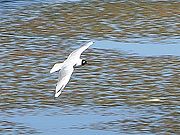
Charadriiformes
Charadriiformes is a diverse order of small to medium-large birds. It includes about 350 species and has members in all parts of the world. Most Charadriiformes live near water and eat invertebrates or other small animals; however, some are pelagic , some occupy deserts and a few are found in thick...
. Family: Laridae
Laridae is a family of medium to large birds seabirds and includes gull
Gull
Gulls are birds in the family Laridae. They are most closely related to the terns and only distantly related to auks, skimmers, and more distantly to the waders...
s and kittiwake
Kittiwake
The kittiwakes are two closely related seabird species in the gull family Laridae, the Black-legged Kittiwake and the Red-legged Kittiwake . The epithets "Black-legged" and "Red-legged" are used to distinguish the two species in North America, but in Europe, where R...
s. They are typically grey or white, often with black markings on the head or wings. They have stout, longish bills and webbed feet. There are 55 species worldwide and 11 species which occur in Chile.
- Dolphin GullDolphin GullThe Dolphin Gull , sometimes erroneously called the Red-billed Gull , is a gull native to southern Chile and Argentina, and the Falkland Islands. It is a coastal bird inhabiting rocky, muddy and sandy shores and is often found around seabird colonies...
Larus scoresbii - Belcher's GullBelcher's GullThe Belcher's Gull , also known as the or Band-tailed Gull, is a gull found along the Pacific coast of South America. It formerly included the very similar Olrog's Gull as a subspecies. It is a medium-sized gull with a blackish mantle, white head and underparts, a black band in the otherwise white...
Larus belcheri - Gray Gull Larus modestus
- Kelp GullKelp GullThe Kelp Gull , also known as the Dominican Gull, breeds on coasts and islands through much of the southern hemisphere. The race L. d. vetula occurs around southern Africa, and nominate L. d...
Larus dominicanus - Gray-headed Gull Larus cirrocephalus (A)
- Brown-hooded GullBrown-hooded GullThe Brown-hooded Gull is a species of gull in the Laridae family. As is the case with many gulls, it has traditionally been placed in the genus Larus....
Larus maculipennis - Andean GullAndean GullThe Andean Gull is a species of gull in the Laridae family. As is the case with many gulls, it has traditionally been placed in the genus Larus.It is found in Argentina, Bolivia, Chile, Colombia, Ecuador, and Peru....
Larus serranus - Laughing GullLaughing GullThe Laughing Gull, Leucophaeus atricilla, is a medium-sized gull of North and South America. It breeds on the Atlantic coast of North America, the Caribbean, and northern South America. Northernmost populations migrate further south in winter, and this species occurs as a rare vagrant to western...
Larus atricilla (A) - Franklin's GullFranklin's GullThe Franklin's Gull is a small gull.-Description:It breeds in central provinces of Canada and adjacent states of the northern United States...
Larus pipixcan - Sabine's GullSabine's GullThe Sabine's Gull is a small gull. Its generic placement is disputed; some authors treat it as the sole species in the genus Xema as Xema sabini, while others retain it in the genus Larus as Larus sabini. It breeds in the arctic and has a circumpolar distribution through northernmost North America...
Xema sabini - Swallow-tailed GullSwallow-tailed GullThe Swallow-tailed Gull is an equatorial seabird in the gull family Laridae. It is the only species in the genus Creagrus, which derives from the Latin Creagra and the Greek kreourgos which means butcher, also from kreas, meat; according to Jobling it would mean "hook for meat" referring to the...
Creagrus furcatus
Terns
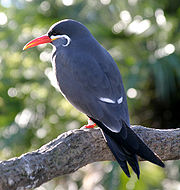
Charadriiformes
Charadriiformes is a diverse order of small to medium-large birds. It includes about 350 species and has members in all parts of the world. Most Charadriiformes live near water and eat invertebrates or other small animals; however, some are pelagic , some occupy deserts and a few are found in thick...
. Family: Sternidae
Tern
Tern
Terns are seabirds in the family Sternidae, previously considered a subfamily of the gull family Laridae . They form a lineage with the gulls and skimmers which in turn is related to skuas and auks...
s are a group of generally general medium to large sea-birds typically with grey or white plumage, often with black markings on the head. Most terns hunt fish by diving but some pick insects off the surface of fresh water. Terns are generally long-lived birds, with several species now known to live in excess of 25 to 30 years. There are 44 species worldwide and 18 species which occur in Chile.
- Elegant TernElegant TernThe Elegant Tern is a seabird of the tern family Sternidae. It breeds on the Pacific coasts of the southern USA and Mexico and winters south to Peru, Ecuador and Chile....
Sterna elegans - Sandwich Tern Sterna sandvicensis (A)
- Royal TernRoyal TernThe Royal Tern is a seabird in the tern family Sternidae. This bird has two distinctive subspecies. T. m. maximus breeds on the Atlantic and Pacific coasts of the southern USA and Mexico into the Caribbean. The slightly smaller T. m. albididorsalis breeds in coastal west Africa...
Sterna maxima (A) - South American TernSouth American TernThe South American Tern is a species of tern found in coastal regions of southern South America, including the Falkland Islands, ranging north to Peru and Brazil . It is generally the commonest tern in its range. It closely resembles the smaller, highly migratory Common Tern.-References:*...
Sterna hirundinacea - Common TernCommon TernThe Common Tern is a seabird of the tern family Sternidae. This bird has a circumpolar distribution, breeding in temperate and sub-Arctic regions of Europe, Asia and east and central North America. It is strongly migratory, wintering in coastal tropical and subtropical regions. It is sometimes...
Sterna hirundo - Arctic TernArctic TernThe Arctic Tern is a seabird of the tern family Sternidae. This bird has a circumpolar breeding distribution covering the Arctic and sub-Arctic regions of Europe, Asia, and North America...
Sterna paradisaea - Antarctic TernAntarctic TernThe Antarctic Tern is a typical tern. It ranges throughout the southern oceans. It is very similar in appearance to the closely related Arctic Tern, but is stockier, and the wing tips are grey instead of blackish in flight...
Sterna vittata (Ant) - Snowy-crowned TernSnowy-crowned TernThe Snowy-crowned Tern or Trudeau's Tern is a species of tern in the Sternidae family.It is found in Argentina, south-east Brazil, Chile, Paraguay and Uruguay. It has occurred as a vagrant in the Falkland Islands....
Sterna trudeaui - Peruvian TernPeruvian TernThe Peruvian Tern is a species of tern in the Sternidae family.It is found in northern Chile, Ecuador, and Peru.Its natural habitats are hot deserts, sandy shores, and coastal saline lagoons.It is threatened by habitat loss....
Sterna lorata - Gray-backed Tern Sterna lunata
- Bridled TernBridled TernThe Bridled Tern is a seabird of the tern family Sternidae. It is a bird of the tropical oceans.-Description:...
Sterna anaethetus (A) - Sooty TernSooty TernThe Sooty Tern, Onychoprion fuscatus , is a seabird of the tern family . It is a bird of the tropical oceans, breeding on islands throughout the equatorial zone. Colloquially, it is known as the Wideawake Tern or just wideawake...
Sterna fuscata - Black TernBlack TernThe Black Tern, Chlidonias niger, is a small tern generally found in or near inland water in Europe and North America. As its name suggests, it has predominantly dark plumage.- Description :...
Chlidonias niger (A) - Black NoddyBlack NoddyThe Black Noddy or White-capped Noddy is a seabird from the tern family. It resembles the closely related Brown or Common Noddy , but is smaller with darker plumage, a whiter cap, a longer, straighter beak and shorter tail...
Anous minutus (A) - Brown NoddyBrown NoddyThe Brown Noddy or Common Noddy is a seabird from the tern family. The largest of the noddies, it can be told from the closely related Black Noddy by its larger size and plumage, which is dark brown rather than black...
Anous stolidus - Gray Noddy Procelsterna albivitta
- White TernWhite TernThe White Tern is a small seabird found across the tropical oceans of the world. It is sometimes known as the Fairy Tern although this name is potentially confusing as it is the common name of the Fairy Tern Sternula nereis...
Gygis alba - Inca TernInca TernThe Inca Tern is a seabird in the family Sternidae. It is the only member of the genus Larosterna.This uniquely-plumaged bird breeds on the coasts of Peru and Chile, and is restricted to the Humboldt current...
Larosterna inca
Skimmers
Order: CharadriiformesCharadriiformes
Charadriiformes is a diverse order of small to medium-large birds. It includes about 350 species and has members in all parts of the world. Most Charadriiformes live near water and eat invertebrates or other small animals; however, some are pelagic , some occupy deserts and a few are found in thick...
. Family: Rynchopidae
Skimmer
Skimmer
The Skimmers, Rynchopidae, are a small family of tern-like birds in the order Charadriiformes, which also includes the waders, gulls and auks. The family comprises three species found in South Asia, Africa, and the Americas....
s are a small family of tropical tern-like birds. They have an elongated lower mandible which they use to feed by flying low over the water surface and skimming the water for small fish. There are 3 species worldwide and 1 species which occurs in Chile.
- Black SkimmerBlack SkimmerThe Black Skimmer, Rynchops niger, is a tern-like seabird, one of three very similar birds species in the skimmer family. It breeds in North and South America...
Rynchops niger
Pigeons and doves
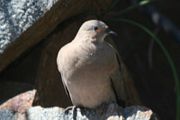
Columbiformes
Columbiformes are an avian order that includes the very widespread and successful doves and pigeons, classified in the family Columbidae, and the extinct Dodo and the Rodrigues Solitaire, long classified as a second family Raphidae. 313 species, found worldwide, comprise the Columbiformes order....
. Family: Columbidae
Pigeons and dove
Dove
Pigeons and doves constitute the bird family Columbidae within the order Columbiformes, which include some 300 species of near passerines. In general terms "dove" and "pigeon" are used somewhat interchangeably...
s are stout-bodied birds with short necks and short slender bills with a fleshy cere
Cère
The Cère is a long river in south-western France, left tributary of the Dordogne River. Its source is in the south-western Massif Central, near the mountain Plomb du Cantal...
. There are 308 species worldwide and 11 species which occur in Chile.
- Rock PigeonRock PigeonThe Rock Dove or Rock Pigeon, is a member of the bird family Columbidae . In common usage, this bird is often simply referred to as the "pigeon"....
Columba livia (I) - Spot-winged PigeonSpot-winged PigeonThe Spot-winged Pigeon is a species of bird in the Columbidae family.It is found in Argentina, Bolivia, Brazil, Paraguay, Peru, and Uruguay....
Patagioenas maculosa (A) - Chilean PigeonChilean PigeonThe Chilean Pigeon is a species of bird in the Columbidae family.It is found in Argentina, Chile, and Falkland Islands.Its natural habitat is temperate forests.-References:...
Patagioenas araucana - Eared DoveEared DoveThe Eared Dove, Zenaida auriculata, is a New World tropical dove. It is a resident breeder throughout South America from Colombia to southern Argentina and Chile, and on the offshore islands from the Grenadines southwards. It may be a relatively recent colonist of Tobago and Trinidad...
Zenaida auriculata - Pacific DovePacific DoveThe West Peruvian Dove is also known as the Pacific Dove, and was first described in 1843 by the Swiss naturalist Johann Jakob Baron von Tschudi. It is classified as LC The West Peruvian Dove (Zenaida meloda) is also known as the Pacific Dove, and was first described in 1843 by the Swiss...
Zenaida meloda - Ruddy Ground DoveRuddy Ground DoveThe Ruddy Ground Dove is a small New World tropical dove. It is a resident breeder from Mexico south to Peru, Brazil and Paraguay, and northern Argentina, and on Trinidad and Tobago...
Columbina talpacoti (A) - Picui Ground Dove Columbina picui
- Croaking Ground Dove Columbina cruziana
- Bare-faced Ground Dove Metriopelia ceciliae
- Black-winged Ground Dove Metriopelia melanoptera
- Golden-spotted Ground Dove Metriopelia aymara
Parrots, macaws and allies
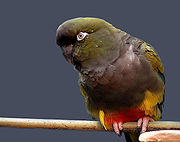
Parrot
Parrot
Parrots, also known as psittacines , are birds of the roughly 372 species in 86 genera that make up the order Psittaciformes, found in most tropical and subtropical regions. The order is subdivided into three families: the Psittacidae , the Cacatuidae and the Strigopidae...
s are small to large birds with a characteristic curved beak shape. Their upper mandibles have slight mobility in the joint with the skull and the have a generally erect stance. All parrots are zygodactyl, having the four toes on each foot placed two at the front and two back. There are 335 species worldwide and 5 species which occur in Chile.
- Burrowing Parrot Cyanoliseus patagonus
- Austral ParakeetAustral ParakeetThe Austral Parakeet, Austral Conure or Emerald Parakeet, Enicognathus ferrugineus, is a parrot found on the southern tip of South America - further south than any other parrot - ranging as far north as Temuco. It is a fairly large conure, 35cm...
Enicognathus ferrugineus - Slender-billed ParakeetSlender-billed ParakeetThe Slender-billed Parakeet , is a bird species in the parrot family. It belongs to the smaller long-tailed Arinae , and is consequently also known as Slender-billed Conure....
Enicognathus leptorhynchus (E) - Monk ParakeetMonk ParakeetThe Monk Parakeet, also known as the Quaker Parrot, is a species of parrot, in most treatments the only member of the genus Myiopsitta. It originates from the temperate to subtropical areas of Argentina and the surrounding countries in South America...
Myiopsitta monachus (I) - Mountain ParakeetMountain ParakeetThe Mountain Parakeet is a species of parrot in the Psittacidae family.It is found in Argentina, Bolivia, Chile, and Peru.Its natural habitat is subtropical or tropical high-altitude shrubland.-References:...
Psilopsiagon aurifrons
Cuckoos and anis

Cuculiformes
The near passerine bird order Cuculiformes traditionally included three families as below:* Musophagidae - turacos and allies* Cuculidae - cuckoos, coucals, roadrunners and anis* Opisthocomidae - Hoatzin...
. Family: Cuculidae
The family Cuculidae includes cuckoo
Cuckoo
The cuckoos are a family, Cuculidae, of near passerine birds. The order Cuculiformes, in addition to the cuckoos, also includes the turacos . Some zoologists and taxonomists have also included the unique Hoatzin in the Cuculiformes, but its taxonomy remains in dispute...
s, roadrunner
Geococcyx
The roadrunners are two species of bird in the genus Geococcyx of the cuckoo family, Cuculidae, native to North and Central America...
s and anis
Ani (bird)
The anis are the three species of near-passerine birds in the genus Crotophaga of the cuckoo family. They are essentially tropical New world birds, although the range of two species just reaches the United States...
. These birds are of variable size with slender bodies, long tails and strong legs. Unlike the cuckoo species of the Old World, North American cuckoos are not brood parasites. There are 138 species worldwide and 2 species which occur in Chile.
- Dark-billed CuckooDark-billed CuckooThe Dark-billed Cuckoo is a species of bird in the Cuculidae family, the cuckoos.It is found in Argentina, Bolivia, Brazil, Colombia, Ecuador, French Guiana, Guyana, Paraguay, Peru, Suriname, Trinidad and Tobago, Uruguay and Venezuela...
Coccyzus melacoryphus - Groove-billed AniGroove-billed AniThe Groove-billed Ani, Crotophaga sulcirostris, is an odd-looking tropical bird in the cuckoo family with a long tail and a large, curved beak. It is a resident species throughout most of its range, from southern Texas and central Mexico through Central America, to northern Colombia and Venezuela,...
Crotophaga sulcirostris
Barn owls
Order: Strigiformes. Family: TytonidaeTytonidae
Barn-owls are one of the two families of owls, the other being the true owls, Strigidae. They are medium to large sized owls with large heads and characteristic heart-shaped faces. They have long, strong legs with powerful talons...
Barn owl
Barn Owl
The Barn Owl is the most widely distributed species of owl, and one of the most widespread of all birds. It is also referred to as Common Barn Owl, to distinguish it from other species in the barn-owl family Tytonidae. These form one of two main lineages of living owls, the other being the typical...
s are medium to large sized owls with large heads and characteristic heart-shaped faces. They have long strong legs with powerful talons. There are 16 species worldwide and 1 species which occurs in Chile.
- Barn OwlBarn OwlThe Barn Owl is the most widely distributed species of owl, and one of the most widespread of all birds. It is also referred to as Common Barn Owl, to distinguish it from other species in the barn-owl family Tytonidae. These form one of two main lineages of living owls, the other being the typical...
Tyto alba
Typical owls
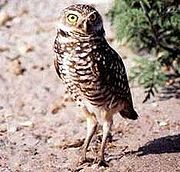
Typical owl
Typical owl
True owl or Typical owl are one of the two generally accepted families of Owls, the other being the barn owls . The Sibley-Ahlquist taxonomy unites the Caprimulgiformes with the owl order; here, the typical owls are a subfamily Strigidae...
s are small to large solitary nocturnal birds of prey. They have large forward-facing eyes and ears, a hawk-like beak, and a conspicuous circle of feathers around each eye called a facial disk. There are 195 species worldwide and 6 species which occur in Chile.
- Magellanic Horned OwlMagellanic Horned OwlThe Lesser Horned Owl or Magellanic Horned Owl is a large owl of the genus Bubo found in southern South America, extending north to the central Andes...
Bubo magellanicus - Rufous-legged OwlRufous-legged OwlThe Rufous-legged Owl is a medium sized owl with no ear tufts. Its upper parts are rufous brown barred with white with more white on the head and nape. It has a rufous facial disk and dark eyes, and its legs and feet are orange-brown to cinnamon. It grows to a size about 33-38 cm long and weighs...
Strix rufipes - Peruvian Pygmy-OwlPeruvian Pygmy-owlThe Pacific Pygmy Owl is a species of owl in the Strigidae family.It is found in Ecuador and Peru.Its natural habitats are subtropical or tropical dry shrubland, subtropical or tropical moist shrubland, subtropical or tropical high-altitude shrubland, and heavily degraded former...
Glaucidium peruanum - Austral Pygmy-OwlAustral Pygmy-owlThe Austral Pygmy Owl is a species of owl in the Strigidae family.It is found in Argentina and Chile.Its natural habitat is temperate forests.-References:* BirdLife International 2004. . Downloaded on 24 July 2007....
Glaucidium nanum - Burrowing OwlBurrowing OwlThe Burrowing Owl is a tiny but long-legged owl found throughout open landscapes of North and South America. Burrowing Owls can be found in grasslands, rangelands, agricultural areas, deserts, or any other open dry area with low vegetation. They nest and roost in burrows, such as those excavated...
Athene cunicularia - Short-eared OwlShort-eared OwlThe Short-eared Owl is a species of typical owl . In Scotland this species of owl is often referred to as a cataface, grass owl or short-horned hootlet. Owls belonging to genus Asio are known as the eared owls, as they have tufts of feathers resembling mammalian ears. These "ear" tufts may or may...
Asio flammeus
Nightjars
Order: CaprimulgiformesCaprimulgiformes
The Caprimulgiformes is an order of birds that includes a number of birds with global distribution . They are generally insectivorous and nocturnal...
. Family: Caprimulgidae
Nightjar
Nightjar
Nightjars are medium-sized nocturnal or crepuscular birds with long wings, short legs and very short bills. They are sometimes referred to as goatsuckers from the mistaken belief that they suck milk from goats . Some New World species are named as nighthawks...
s are medium-sized nocturnal birds with long wings, short legs and very short bills that usually nest on the ground. Most have small feet, of little use for walking, and long pointed wings. Their soft plumage is camouflaged to resemble bark or leaves. There are 86 species worldwide and 2 species which occur in Chile.
- Lesser NighthawkLesser NighthawkThe Lesser Nighthawk, Chordeiles acutipennis, is a nightjar found throughout a large part of the Americas.The adults are dark with brown, grey and white patterning on the upperparts and breast; the long upperwings are black and show a white bar in flight. The tail is dark with white barring; the...
Chordeiles acutipennis (A) - Band-winged NightjarBand-winged NightjarThe Band-winged Nightjar is a species of nightjar in the Caprimulgidae family. It is widespread in South America, where found in the Andes, Venezuelan Coastal Range, Santa Marta Mountains, Tepuis, most of Chile, Argentina, Paraguay, Uruguay and eastern Brazil...
Caprimulgus longirostris
Swifts
Order: ApodiformesApodiformes
Traditionally, the bird order Apodiformes contained three living families: the swifts , the tree swifts , and the hummingbirds . In the Sibley-Ahlquist taxonomy, this order is raised to a superorder Apodimorphae in which hummingbirds are separated as a new order, Trochiliformes...
. Family: Apodidae
Swift
Swift
The swifts are a family, Apodidae, of highly aerial birds. They are superficially similar to swallows, but are actually not closely related to passerine species at all; swifts are in the separate order Apodiformes, which they share with hummingbirds...
s are small aerial birds, spending the majority of their lives flying. These birds have very short legs and never settle voluntarily on the ground, perching instead only on vertical surfaces. Many swifts have long swept-back wings that resemble a crescent or a boomerang. There are 98 species worldwide and 2 species which occur in Chile.
- Chimney SwiftChimney SwiftThe Chimney Swift is a small bird .-Physical description:In flight, this bird looks like a flying cigar with long slender curved wings. The plumage is a sooty grey-brown; the throat, breast, underwings and rump are paler. They have short tails.-Reproduction:The breeding season of Chimney Swifts is...
Chaetura pelagica - Andean SwiftAndean SwiftThe Andean Swift is a species of swift in the Apodidae family.It is found in Argentina, Bolivia, Chile, and Peru.Its natural habitat is subtropical or tropical high-altitude shrubland.-References:...
Aeronautes andecolus
Hummingbirds
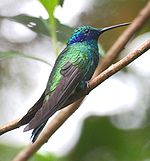
Hummingbird
Hummingbird
Hummingbirds are birds that comprise the family Trochilidae. They are among the smallest of birds, most species measuring in the 7.5–13 cm range. Indeed, the smallest extant bird species is a hummingbird, the 5-cm Bee Hummingbird. They can hover in mid-air by rapidly flapping their wings...
s are small birds capable of hovering in mid-air due to the rapid flapping of their wings. They are the only birds that can fly backwards. There are 337 species worldwide and 9 species which occur in Chile.
- Sparkling Violet-earSparkling Violet-earThe Sparkling Violetear, Colibri coruscans, is a species of hummingbird. It is widespread in highlands of northern and western South America, including a large part of the Andes , the Venezuelan Coastal Range and the Tepuis...
Colibri coruscans - Andean HillstarAndean HillstarThe Andean Hillstar is a species of hummingbird in the Trochilidae family. It is found in grassland, scrub and woodland in the Altiplano of southern Peru, Bolivia, northern Chile, and north-western Argentina...
Oreotrochilus estella - White-sided HillstarWhite-sided HillstarThe White-sided Hillstar is a species of hummingbird in the Trochilidae family. It is the southernmost species of hillstar, being found in grassland and scrub at altitudes of in far southern Bolivia, Chile and western Argentina...
Oreotrochilus leucopleurus - Giant HummingbirdGiant HummingbirdThe Giant Hummingbird is the largest member of the hummingbird family, weighing 18-24 g and measuring approximately 21.5 cm in length. This is approximately the length same length as a European Starling or a Northern Cardinal, though the Giant Hummingbird is considerably lighter due to its...
Patagona gigas - Green-backed FirecrownGreen-backed FirecrownThe Green-backed Firecrown is a hummingbird that is found in Argentina and Chile. It can be fairly common in some locations, especially the Robinson Crusoe Island, 350 miles off the Chilean coast. It is found as far south as Tierra del Fuego.Like its cousin the Juan Fernández Firecrown, the...
Sephanoides sephaniodes - Juan Fernandez FirecrownJuan Fernandez FirecrownThe Juan Fernández Firecrown is a hummingbird found solely on Isla Róbinson Crusoe, one of a three-island archipelago belonging to Chile. It is non-migratory and shares the island with the smaller Green-backed Firecrown, Sephanoides sephaniodes.The population of this species has been in a general...
Sephanoides fernandensis (E) - Oasis HummingbirdOasis HummingbirdThe Oasis Hummingbird is a species of hummingbird in the Trochilidae family.It is found in coastal regions of Peru in a 100-200 km wide strip that extends the length of Peru's coastline, about 3000 km...
Rhodopis vesper - Peruvian SheartailPeruvian SheartailThe Peruvian Sheartail is a species of hummingbird in the Trochilidae family.It is found in Peru west of the Andes and has been recorded in Ecuador...
Thaumastura cora - Chilean WoodstarChilean WoodstarThe Chilean Woodstar is a small bird in the hummingbird family, Trochilidae. It is restricted to northernmost Chile with reports from southern Peru. Its natural habitats are dry shrubland and rural gardens. It is threatened by habitat loss and is classed as an endangered species...
Eulidia yarrellii
Kingfishers
Order: CoraciiformesCoraciiformes
The Coraciiformes are a group of usually colorful near passerine birds including the kingfishers, the Hoopoe, the bee-eaters, the rollers, and the hornbills...
. Family: Alcedinidae
Kingfishers are medium-sized birds with large heads, long pointed bills, short legs, and stubby tails. There are 93 species worldwide and 2 species which occur in Chile.
- Ringed KingfisherRinged KingfisherThe Ringed Kingfisher is a large, conspicuous and noisy kingfisher, commonly found along the lower Rio Grande River valley in southeasternmost Texas in the United States through Central America to Tierra del Fuego in South America....
Ceryle torquatus - Green KingfisherGreen KingfisherThe Green Kingfisher, Chloroceryle americana, is a resident breeding bird which occurs from southern Texas in the USA south through Central and South Americal to central Argentina....
Chloroceryle americana (A)
Woodpeckers and allies

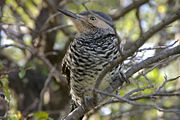
Piciformes
Nine families of largely arboreal birds make up the order Piciformes, the best-known of them being the Picidae, which includes the woodpeckers and close relatives...
. Family: Picidae
Picidae
The woodpeckers, piculets and wrynecks are a family, Picidae, of near-passerine birds. Members of this family are found worldwide, except for Australia and New Zealand, Madagascar, and the extreme polar regions...
Woodpeckers are small to medium sized birds with chisel like beaks, short legs, stiff tails and long tongues used for capturing insects. Some species have feet with two toes pointing forward, and two backward, while several species have only three toes. Many woodpeckers have the habit of tapping noisily on tree trunks with their beaks. There are 218 species worldwide and 4 species which occur in Chile.
- Striped WoodpeckerStriped WoodpeckerThe Striped Woodpecker is a woodpecker found in southwestern South America. It occurs northwest- and southwestwards of the range of its sister taxon, the Checkered Woodpecker, in the Cordillera Patagonica and its foothills, and in another population in the Andes of Bolivia and the adjacent...
Picoides lignarius - Chilean FlickerChilean FlickerThe Chilean Flicker is a species of bird in the Picidae family.It is found in Argentina and Chile.Its natural habitats are temperate forests, subtropical or tropical high-altitude shrubland, and heavily degraded former forest....
Colaptes pitius - Andean FlickerAndean FlickerThe Andean Flicker is a South American species of woodpecker. It is found in grassland, shrubland and Polylepis woodland at altitudes of in the Andes from southern Ecuador to northern Chile and northwestern Argentina...
Colaptes rupicola - Magellanic WoodpeckerMagellanic WoodpeckerThe Magellanic Woodpecker is a very large woodpecker resident to Chile along the Andes, and to some parts of southwestern Argentina. This species is the southern-most example of the genus Campephilus, which includes the famous Ivory-billed Woodpecker.The Magellanic Woodpecker is 45 cm in length...
Campephilus magellanicus
Ovenbirds
Order: Passeriformes. Family: FurnariidaeOvenbirds comprise a large family of small sub-oscine passerine bird species found in Central and South America. They are a diverse group of insectivores which gets its name from the elaborate "oven-like" clay nests built by some species, although others build stick nests or nest in tunnels or clefts in rock. There are 243 species worldwide and 32 species which occur in Chile.
- Grayish Miner Geositta maritima
- Common MinerCommon MinerThe Common Miner is a passerine bird of South America, belonging to the ovenbird family. It is a ground-dwelling bird which feeds on insects and seeds. It has about 9 different subspecies, some of which may be better treated as separate species.It is 14 to 16 cm long with a fairly long,...
Geositta cunicularia - Puna MinerPuna MinerThe Puna Miner is a species of bird in the Furnariidae family.It is found in Argentina, Bolivia, Chile, and Peru.Its natural habitat is subtropical or tropical high-altitude grassland.-References:...
Geositta punensis - Short-billed MinerShort-billed MinerThe Short-billed Miner is a species of bird in the Furnariidae family.It is found in Argentina and Chile.Its natural habitat is temperate grassland.-References:...
Geositta antarctica - Rufous-banded MinerRufous-banded MinerThe Rufous-banded Miner is a species of bird in the Furnariidae family.It is found in Argentina, Bolivia, and Chile. Its natural habitats are subtropical or tropical high-altitude shrubland and subtropical or tropical high-altitude grassland.-References:* BirdLife International 2004. . ...
Geositta rufipennis - Creamy-rumped MinerCreamy-rumped MinerThe Creamy-rumped Miner is a species of bird in the Furnariidae family.It is found in Argentina and Chile.Its natural habitat is subtropical or tropical high-altitude grassland.-References:...
Geositta isabellina - Scale-throated EarthcreeperScale-throated EarthcreeperThe Scaly-throated Earthcreeper is a species of bird in the Furnariidae family. It is found in Argentina, Bolivia, Chile, Peru, and Uruguay. Its natural habitats are subtropical or tropical dry shrubland, subtropical or tropical high-altitude shrubland, and subtropical or tropical high-altitude...
Upucerthia dumetaria - Plain-breasted EarthcreeperPlain-breasted EarthcreeperThe Plain-breasted Earthcreeper is a species of bird in the Furnariidae family.It is found in Argentina, Bolivia, Chile, and Peru....
Upucerthia jelskii - White-throated EarthcreeperWhite-throated EarthcreeperThe White-throated Earthcreeper is a species of bird in the Furnariidae family.It is found in Chile and Peru.Its natural habitat is subtropical or tropical high-altitude shrubland.-References:...
Upucerthia albigula - Straight-billed EarthcreeperStraight-billed EarthcreeperThe Straight-billed Earthcreeper is a species of bird in the Furnariidae family.It is found in Argentina, Bolivia, Chile, and Peru.Its natural habitat is subtropical or tropical high-altitude shrubland.-References:...
Upucerthia ruficauda - Rock EarthcreeperRock EarthcreeperThe Rock Earthcreeper is a species of bird in the Furnariidae family.It is found in Argentina, Bolivia, and Chile. Its natural habitats are subtropical or tropical high-altitude shrubland and subtropical or tropical high-altitude grassland.-References:* BirdLife International 2004. . ...
Upucerthia andaecola (A) - Band-tailed EarthcreeperBand-tailed EarthcreeperThe Band-tailed Earthcreeper is a species of bird in the Furnariidae family. It has traditionally been placed in the monotypic genus Eremobius, but recent evidence suggests it should be moved to Ochetorhynchus.It is found in Argentina and Chile.Its natural habitats are subtropical or tropical dry...
Eremobius phoenicurus - Crag ChiliaCrag ChiliaThe Crag Chilia is a species of bird in the Furnariidae family. It has traditionally been placed in the monotypic genus Chilia, but recent evidence suggests it should be moved to Ochetorhynchus....
Chilia melanura (E) - Blackish CinclodesBlackish CinclodesThe Blackish Cinclodes is a passerine bird of the genus Cinclodes belonging to the ovenbird family Furnariidae. It is native to the southern tip of South America including the Falkland Islands where it is known as the Tussac-bird or Tussock-bird. It is often very tame and will approach humans...
Cinclodes antarcticus - Chilean Seaside Cinclodes Cinclodes nigrofumosus (E)
- Dark-bellied CinclodesDark-bellied CinclodesThe Dark-bellied Cinclodes is a species of bird in the Furnariidae family.It is found in Argentina and Chile.Its natural habitats are rivers and rocky shores....
Cinclodes patagonicus - Gray-flanked Cinclodes Cinclodes oustaleti
- Bar-winged CinclodesBar-winged CinclodesThe Bar-winged Cinclodes is a species of bird in the Furnariidae family. It is found in Argentina, Bolivia, Brazil, Chile, Colombia, Ecuador, Paraguay, Peru, Uruguay, and Venezuela....
Cinclodes fuscus - White-winged CinclodesWhite-winged CinclodesThe White-winged Cinclodes is a species of bird in the Furnariidae family.It is found in Argentina, Bolivia, Chile, and Peru.Its natural habitats are subtropical or tropical high-altitude grassland and rivers.-References:...
Cinclodes atacamensis - Des Murs's WiretailDes Murs's WiretailDes Murs's Wiretail is a small passerine bird of southern South America which belongs to the ovenbird family Furnariidae. It is the only member of the genus Sylviorthorhynchus...
Sylviorthorhynchus desmursii - Thorn-tailed RayaditoThorn-tailed RayaditoThe Thorn-tailed Rayadito is a species of bird in the Furnariidae family.It is found in Argentina and Chile and may formerly have occurred in the Falkland Islands....
Aphrastura spinicauda - Masafuera RayaditoMasafuera RayaditoThe Masafuera Rayadito, Aphrastura masafuerae, is a rare bird endemic to Alejandro Selkirk Island in the Juan Fernández Islands. The species is a member of the ovenbird family and only one of two species in the rayadito genus...
Aphrastura masafuerae (E) - Streaked Tit-SpinetailStreaked Tit-spinetailThe Streak-backed Tit-spinetail is a species of bird in the Furnariidae family. It is found in Chile and Peru....
Leptasthenura striata - Plain-mantled Tit-SpinetailPlain-mantled Tit-spinetailThe Plain-mantled Tit-spinetail is a small passerine bird of South America belonging to the ovenbird family, Furnariidae. It is a common bird across much of Chile, southern and eastern Argentina, southern Peru and western Bolivia...
Leptasthenura aegithaloides - Wren-like RushbirdWren-like RushbirdThe Wren-like Rushbird is a species of bird in the Furnariidae family. It is monotypic within the genus Phleocryptes.It is found in Argentina, Bolivia, Brazil, Chile, Paraguay, Peru, and Uruguay....
Phleocryptes melanops - Dark-winged Canastero Asthenes arequipae
- Lesser Canastero Asthenes pyrrholeuca
- Dusky-tailed CanasteroDusky-tailed CanasteroThe Dusky-tailed Canastero is a species of bird in the Furnariidae family. It is found in Argentina and Chile. Its natural habitats are subtropical or tropical dry shrubland and subtropical or tropical high-altitude shrubland....
Asthenes humicola (E?) - Canyon CanasteroCanyon CanasteroThe Canyon Canastero is a species of bird in the Furnariidae family. It is found in Chile and Peru. Its natural habitats are subtropical or tropical moist montanes and subtropical or tropical high-altitude shrubland.-References:...
Asthenes pudibunda (A) - Cordilleran CanasteroCordilleran CanasteroThe Cordilleran Canastero is a species of bird in the Furnariidae family.It is found in Argentina, Bolivia, Chile, and Peru.Its natural habitats are temperate grassland and subtropical or tropical high-altitude grassland....
Asthenes modesta - Austral CanasteroAustral CanasteroThe Austral Canastero is a species of bird in the Furnariidae family, the ovenbirds.It is found in southern Argentina and northern regions of Tierra del Fuego; the range extends northwestwards into southern Chile, as a migration region in the austral winter...
Asthenes anthoides - White-throated TreerunnerWhite-throated TreerunnerThe White-throated Treerunner is a species of bird in the Furnariidae family. It is monotypic within the genus Pygarrhichas.It is found in Chile and Argentina, also southern regions of Tierra del Fuego....
Pygarrhichas albogularis
Tapaculos
Order: Passeriformes. Family: RhinocryptidaeThe tapaculos are a group of small suboscine passeriform bird
Bird
Birds are feathered, winged, bipedal, endothermic , egg-laying, vertebrate animals. Around 10,000 living species and 188 families makes them the most speciose class of tetrapod vertebrates. They inhabit ecosystems across the globe, from the Arctic to the Antarctic. Extant birds range in size from...
s with numerous species, found in South America
South America
South America is a continent situated in the Western Hemisphere, mostly in the Southern Hemisphere, with a relatively small portion in the Northern Hemisphere. The continent is also considered a subcontinent of the Americas. It is bordered on the west by the Pacific Ocean and on the north and east...
. They are terrestrial species that fly only poorly on their short wings. They have strong legs, well-suited to their habitat of grassland or forest undergrowth. The tail is cocked and pointed towards the head. There are 56 species worldwide and 8 species which occur in Chile.
- Black-throated Huet-huetBlack-throated Huet-huetThe Black-throated Huet-huet is a species of bird in the Rhinocryptidae family.It is found in Argentina and Chile.Its natural habitat is temperate forests.-References:...
Pteroptochos tarnii - Chestnut-throated Huet-huetChestnut-throated Huet-huetThe Chestnut-throated Huet-huet is a species of bird in the Rhinocryptidae family.It is found in Argentina and Chile.Its natural habitats are temperate forests and heavily degraded former forest.-References:...
Pteroptochos castaneus - Moustached TurcaMoustached TurcaThe Moustached Turca is a passerine bird which is endemic to Chile. It belongs to the tapaculo group and is a member of the genus Pteroptochos, along with the two species of huet-huet....
Pteroptochos megapodius (E) - White-throated TapaculoWhite-throated TapaculoThe White-throated Tapaculo is a species of bird in the Rhinocryptidae family.It is endemic to Chile.Its natural habitats are subtropical or tropical dry shrubland and subtropical or tropical high-altitude shrubland....
Scelorchilus albicollis (E) - Chucao TapaculoChucao TapaculoThe Chucao Tapaculo is a species of bird in the Rhinocryptidae family.It is found in Argentina and Chile.Its natural habitat is temperate forests.-References:...
Scelorchilus rubecula - Ochre-flanked TapaculoOchre-flanked TapaculoThe Ochre-flanked Tapaculo is a species of bird in the Rhinocryptidae family. It is monotypic within the genus Eugralla.It is found in Argentina and Chile.Its natural habitat is temperate forests.-References:...
Eugralla paradoxa - Magellanic TapaculoMagellanic TapaculoThe Magellanic Tapaculo is a small passerine bird of southern South America. It belongs to the genus Scytalopus, a genus of tapaculos.-Taxonomy:...
Scytalopus magellanicus - Dusky TapaculoDusky TapaculoThe Dusky Tapaculo is a species of bird in the Rhinocryptidae family.It is endemic to Chile.Its natural habitat is temperate forests.-References:* BirdLife International 2004. . Downloaded on 27 July 2007....
Scytalopus fuscus (E)
Cotingas
Order: Passeriformes. Family: CotingidaeThe cotingas are birds of forests or forest edges of tropical South America. Comparatively little is known about this diverse group, although all have broad bills with hooked tips, rounded wings, and strong legs. The males of many of the species are brightly coloured, or decorated with plumes or wattles. There are 71 species worldwide and 1 species which occurs in Chile
- Rufous-tailed PlantcutterRufous-tailed PlantcutterThe Rufous-tailed Plantcutter is a fairly small passerine bird of southern South America, now placed in the cotinga family....
Phytotoma rara
Tyrant flycatchers
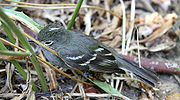
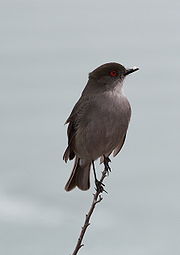

Tyrant flycatcher
Tyrant flycatcher
The tyrant flycatchers are a family of passerine birds which occur throughout North and South America. They are considered the largest family of birds on Earth, with more than 400 species. They are the most diverse avian family in every country in the Americas, except for the United States and...
s are passerine
Passerine
A passerine is a bird of the order Passeriformes, which includes more than half of all bird species. Sometimes known as perching birds or, less accurately, as songbirds, the passerines form one of the most diverse terrestrial vertebrate orders: with over 5,000 identified species, it has roughly...
birds which occur throughout North and South America. They superficially resemble the Old World flycatchers, but are more robust with stronger bills. They do not have the sophisticated vocal capabilities of the songbirds. Most, but not all, have plain colouring. As the name implies, most are insectivorous. There are 429 species worldwide, all found only in the Americas and 38 species which occur in Chile.
- White-crested ElaeniaWhite-crested ElaeniaThe White-crested Elaenia is a species of bird in the Tyrannidae family, the tyrant flycatchers. It has several subspecies breeding across southern and western parts of South America...
Elaenia albiceps - Pied-crested Tit-TyrantPied-crested Tit-tyrantThe Pied-crested Tit-tyrant is a species of bird in the Tyrannidae family. It is found in Chile and Peru.Its natural habitats are subtropical or tropical moist shrubland and subtropical or tropical high-altitude shrubland....
Anairetes reguloides - Yellow-billed Tit-TyrantYellow-billed Tit-TyrantThe Yellow-billed Tit-Tyrant is a species of bird in the Tyrannidae family. It is found in Argentina, Bolivia, Chile, and Peru....
Anairetes flavirostris - Juan Fernandez Tit-TyrantJuan Fernández Tit-TyrantThe Juan Fernández Tit-Tyrant is a species of bird in the Tyrannidae family. It is endemic to the Juan Fernández Islands....
Anairetes fernandezianus (E) - Tufted Tit-TyrantTufted Tit-Tyrantleft|400pxThe Tufted Tit-tyrant is a species of bird in the Tyrannidae family. It is found in Argentina, Bolivia, Chile, Colombia, Ecuador, Falkland Islands, and Peru.Its natural habitats are temperate forests, subtropical or tropical moist montane forests, subtropical or tropical high-altitude...
Anairetes parulus - Many-colored Rush-Tyrant Tachuris rubrigastra
- Warbling DoraditoWarbling DoraditoThe Warbling Doradito is a species of bird in the Tyrannidae family. It is found in swamps and riparian habitats in central and northern Argentina, Paraguay, Uruguay and southern Brazil. The population breeding in Chile and western Argentina has usually also been included in the Warbling Doradito...
Pseudocolopteryx flaviventris - Bran-colored FlycatcherBran-colored FlycatcherThe Bran-colored Flycatcher, Myiophobus fasciatus, is a small passerine bird in the tyrant flycatcher family. It breeds from Costa Rica through South America to Bolivia, Uruguay, and Argentina. It also occurs on Trinidad....
Myiophobus fasciatus - Vermilion FlycatcherVermilion FlycatcherThe Vermilion Flycatcher is a small passerine bird in the Tyrannidae, or tyrant flycatcher family. Most flycatchers are rather drab, but the Vermilion Flycatcher is a striking exception...
Pyrocephalus rubinus - D'Orbigny's Chat-TyrantD'Orbigny's Chat-tyrantThe D'Orbigny's Chat-tyrant is a species of bird in the Tyrannidae family.It is found in Argentina, Bolivia, Chile, and Peru....
Ochthoeca oenanthoides - White-browed Chat-TyrantWhite-browed Chat-tyrantThe White-browed Chat-tyrant is a species of bird in the Tyrannidae family. It is found in Argentina, Bolivia, Chile, Ecuador, and Peru.Its natural habitat is subtropical or tropical high-altitude shrubland.-References:...
Ochthoeca leucophrys - Patagonian TyrantPatagonian TyrantThe Patagonian Tyrant is a species of bird in the Tyrannidae family, the only one in the genus Colorhamphus.It is found in Argentina and Chile.Its natural habitat is temperate forests....
Colorhamphus parvirostris - Fire-eyed DiuconFire-eyed DiuconThe Fire-eyed Diucon is a passerine bird of South America belonging to the tyrant flycatcher family Tyrannidae. It is usually placed with the monjitas in the genus Xolmis but was sometimes placed in its own genus Pyrope in the past....
Xolmis pyrope - Chocolate-vented TyrantChocolate-vented TyrantThe Chocolate-vented Tyrant is a species of bird in the Tyrannidae family. It is placed in the monotypic genus Neoxolmis. The species was first scientifically described by Vieillot in 1823....
Neoxolmis rufiventris - Black-billed Shrike-TyrantBlack-billed Shrike-tyrantThe Black-billed Shrike-tyrant is a species of bird in the Tyrannidae family. It is found in Argentina, Bolivia, Chile, Colombia, Ecuador, Peru, and is a vagrant to the Falkland Islands. It is a large flycatcher at 23-25 cm long...
Agriornis montana - White-tailed Shrike-TyrantWhite-tailed Shrike-tyrantThe White-tailed Shrike-tyrant is a species of bird in the Tyrannidae family. It is found in Argentina, Bolivia, Chile, Ecuador, and Peru...
Agriornis andicola - Great Shrike-TyrantGreat Shrike-tyrantThe Great Shrike-tyrant is a species of bird in the Tyrannidae family.It is found in Argentina and Chile.It is the largest species of tyrant flycatcher at 27.5-31 cm long...
Agriornis livida - Gray-bellied Shrike-Tyrant Agriornis microptera
- Rufous-webbed Tyrant Polioxolmis rufipennis (A)
- Spot-billed Ground-TyrantSpot-billed Ground-tyrantThe Spot-billed Ground-tyrant is a species of bird in the Tyrannidae family.It is found in Argentina, Bolivia, Chile, Colombia, Ecuador, and Peru. Its natural habitats are subtropical or tropical high-altitude shrubland and pastureland.-References:* BirdLife International 2004. . Downloaded...
Muscisaxicola maculirostris - Dark-faced Ground-TyrantDark-faced Ground-tyrantThe Dark-faced Ground-tyrant is a small passerine bird belonging to the tyrant flycatcher family. It is a ground-dwelling bird of southern South America which feeds on small invertebrates such as flies and moths....
Muscisaxicola maclovianus - Cinnamon-bellied Ground-TyrantCinnamon-bellied Ground-tyrantThe Cinnamon-bellied Ground-tyrant is a species of bird in the Tyrannidae family, the tyrant flycatchers.It is found in western Argentina, eastern Andean Chile, southwest Bolivia, and southern Peru....
Muscisaxicola capistratus - Rufous-naped Ground-TyrantRufous-naped Ground-tyrantThe Rufous-naped Ground-tyrant is a species of bird in the Tyrannidae family.It is found in Argentina, Bolivia, Chile, and Peru....
Muscisaxicola rufivertex - Puna Ground-TyrantPuna Ground-tyrantThe Puna Ground-tyrant is a species of bird in the Tyrannidae family.It is found in Argentina, Bolivia, Chile, and Peru.Its natural habitats are subtropical or tropical high-altitude grassland and swamps.- References :...
Muscisaxicola juninensis - White-browed Ground-TyrantWhite-browed Ground-tyrantThe White-browed Ground-tyrant is a species of bird in the Tyrannidae family.It breeds in the Andes in Argentina and Chile between 1,500 and 4,000 m above sea-level. It migrates north to Bolivia, Colombia, Ecuador and Peru. It is a vagrant to the Falkland Islands...
Muscisaxicola albilora - Cinereous Ground-TyrantCinereous Ground-tyrantThe Cinereous Ground-tyrant is a species of bird in the Tyrannidae family. The term cinereous describes its colouration. It is found in Argentina, Bolivia, Chile, and Peru. Its natural habitat is subtropical or tropical high-altitude grassland.- References :* BirdLife International 2004. . ...
Muscisaxicola cinereus - White-fronted Ground-TyrantWhite-fronted Ground-tyrantThe White-fronted Ground-tyrant is a species of bird in the Tyrannidae family.It is found in Bolivia, Chile, and Peru.Its natural habitats are subtropical or tropical high-altitude grassland and swamps.-References:...
Muscisaxicola albifrons - Ochre-naped Ground-TyrantOchre-naped Ground-tyrantThe Ochre-naped Ground-tyrant is a species of bird in the Tyrannidae family, the tyrant flycatchers, specifically the ground-tyrants.It is found in Argentina, Bolivia, Chile, and Peru....
Muscisaxicola flavinucha - Black-fronted Ground-TyrantBlack-fronted Ground-tyrantThe Black-fronted Ground-tyrant is a species of bird in the Tyrannidae family.It is found in Argentina, Bolivia, Chile, and Peru.Its natural habitat is subtropical or tropical high-altitude grassland.-References:...
Muscisaxicola frontalis - Short-tailed Field-TyrantShort-tailed Field-tyrantThe Short-tailed Field-tyrant is a species of bird in the Tyrannidae family. It is monotypic within the genus Muscigralla....
Muscigralla brevicauda - Andean NegritoAndean NegritoThe Andean Negrito is a species of bird in the Tyrannidae family.It is found in Argentina, Bolivia, Chile, and Peru.Its natural habitats are freshwater lakes and saline marshes.-References:...
Lessonia oreas - Austral Negrito Lessonia rufa
- Spectacled TyrantSpectacled TyrantThe Spectacled Tyrant is a species of bird in the Tyrannidae family, the only one in the genus Hymenops.It is found in Argentina, Bolivia, Brazil, Chile, Paraguay, Peru, and Uruguay....
Hymenops perspicillatus - Great KiskadeeGreat KiskadeeThe Great Kiskadee, Pitangus sulphuratus, is a passerine bird. It is a large tyrant flycatcher; sometimes its genus Pitangus is considered monotypic, with the Lesser Kiskadee The Great Kiskadee, Pitangus sulphuratus, is a passerine bird. It is a large tyrant flycatcher; sometimes its genus Pitangus...
Pitangus sulphuratus (A) - Streaked FlycatcherStreaked FlycatcherThe Streaked Flycatcher, Myiodynastes maculatus, is a passerine bird in the tyrant flycatcher family. It breeds from eastern Mexico, Trinidad and Tobago south to Bolivia and Argentina. The southern subspecies M. m...
Myiodynastes maculatus (A) - Tropical KingbirdTropical KingbirdThe Tropical Kingbird is a large tyrant flycatcher. This bird breeds from southern Arizona and the lower Rio Grande Valley of Texas in the USA through Central America, South America as far as south as central Argentina and western Peru, and on Trinidad and Tobago...
Tyrannus melancholicus (A) - Eastern KingbirdEastern KingbirdThe Eastern Kingbird, Tyrannus tyrannus, is a large Tyrant flycatcher.Adults are grey-black on the upperparts with light underparts; they have a long black tail with a white end and long pointed wings. They have a red patch on their crown, seldom seen...
Tyrannus tyrannus (A) - Fork-tailed FlycatcherFork-tailed FlycatcherThe Fork-tailed Flycatcher, Tyrannus savana, is a passerine bird of the tyrant flycatcher family, and is the member of a genus typically referred to as kingbirds.-Description and ecology:...
Tyrannus savana (A)
Swallows and martins

The Hirundinidae family is a group of passerines characterized by their adaptation to aerial feeding. Their adaptations include a slender streamlined body, long pointed wings and short bills with wide gape. The feet are designed for perching rather than walking, and the front toes are partially joined at the base. There are 75 species worldwide and 9 species which occur in Chile.
- Southern MartinSouthern MartinThe Southern Martin is a species of bird in the Hirundinidae family.It is found in Argentina, Bolivia, Brazil, Colombia, Ecuador, Panama, Paraguay, Peru, and Uruguay....
Progne elegans (A) - Peruvian MartinPeruvian MartinThe Peruvian Martin is a species of bird in the Hirundinidae family. It is found in Chile and Peru.Its natural habitats are subtropical or tropical moist lowland forests, subtropical or tropical moist montanes, subtropical or tropical dry lowland grassland, subtropical or tropical high-altitude...
Progne murphyi - Chilean SwallowChilean SwallowThe Chilean Swallow is a species of bird in the Hirundinidae family. It breeds in Argentina, Chile and the Falkland Islands with southern birds migrating north as far as Bolivia, Brazil, Paraguay, Uruguay and possibly Peru....
Tachycineta meyeni - Blue-and-white SwallowBlue-and-white SwallowThe Blue-and-white Swallow is a passerine bird that breeds from Nicaragua south throughout South America, except in the deserts and the Amazon Basin. The southern race is migratory, wintering as far north as Trinidad, where it is a regular visitor...
Notiochelidon cyanoleuca - Andean SwallowAndean SwallowThe Andean Swallow is a species of bird in the Hirundinidae family. It is monotypic within the genus Haplochelidon.It is found in Argentina, Bolivia, Chile, and Peru....
Haplochelidon andecola - Tawny-headed SwallowTawny-headed SwallowThe Tawny-headed Swallow is a species of bird in the Hirundinidae family. It is monotypic within the genus Alopochelidon....
Alopochelidon fucata (A) - Bank Swallow Riparia riparia (A)
- Cliff SwallowCliff SwallowThe Cliff Swallow is a member of the passerine bird family Hirundinidae — the swallows and martins.It breeds in North America, and is migratory, wintering in western South America from Venezuela southwards to northeast Argentina...
Petrochelidon pyrrhonota (A) - Barn SwallowBarn SwallowThe Barn Swallow is the most widespread species of swallow in the world. It is a distinctive passerine bird with blue upperparts, a long, deeply forked tail and curved, pointed wings. It is found in Europe, Asia, Africa and the Americas...
Hirundo rustica
Wagtails and pipits
Order: Passeriformes. Family: MotacillidaeMotacillidae
The Motacillidae are a family of small passerine birds with medium to long tails. There are around 65 species in 6 genera and they include the wagtails, longclaws and pipits. The longclaws are entirely restricted to the Afrotropics, and the wagtails are predominately found in Europe, Africa and...
The Motacillidae are a family of small passerine birds with medium to long tails. They include the wagtails, longclaws and pipits. They are slender, ground feeding insectivores of open country. There are 54 species worldwide and 3 species which occur in Chile.
- Correndera PipitCorrendera PipitThe Correndera Pipit is a species of bird in the Motacillidae family.It is found in Argentina, Bolivia, southern Brazil, Chile, the Falkland Islands, Paraguay, Peru, and Uruguay....
Anthus correndera - Hellmayr's PipitHellmayr's PipitThe Hellmayr's Pipit is a species of bird in the Motacillidae family.It is found in Argentina, Bolivia, Brazil, Chile, Paraguay, Peru, and Uruguay....
Anthus hellmayri - Yellowish PipitYellowish PipitThe Yellowish Pipit is a species of bird in the Motacillidae family.It is found in Argentina, Bolivia, Brazil, Chile, Colombia, French Guiana, Guyana, Panama, Paraguay, Peru, Suriname, Uruguay, and Venezuela....
Anthus lutescens
Wrens
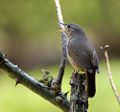
The wren
Wren
The wrens are passerine birds in the mainly New World family Troglodytidae. There are approximately 80 species of true wrens in approximately 20 genera....
s are mainly small and inconspicuous except for their loud songs. These birds have short wings and a thin down-turned bill. Several species often hold their tails upright. All are insectivorous. There are 80 species worldwide (of which all but one are New World species) and 2 species which occur in Chile.
- House WrenHouse WrenThe House Wren, Troglodytes aedon, is a very small songbird of the wren family, Troglodytidae. It occurs from Canada to southernmost South America, and is thus the most widely distributed bird in the Americas. It occurs in most suburban areas in its range and it is the single most common wren...
Troglodytes aedon - Sedge WrenSedge WrenThe Sedge Wren, Cistothorus platensis, is a small songbird of the Wren family. It was formerly known as the Short-billed Marsh Wren, and in South America is known as the Grass Wren. There are about 20 different subspecies which are found across most of the Americas...
Cistothorus platensis
Mockingbirds and Thrashers

The mimids are a family of passerine birds that includes thrasher
Thrasher
Thrashers are a New World group of passerine birds related to mockingbirds and New World catbirds. Like these, they are in the Mimidae family. There are 15 species in one large and 4 monotypic genera.These do not form a clade but are a phenetic assemblage...
s, mockingbird
Mockingbird
Mockingbirds are a group of New World passerine birds from the Mimidae family. They are best known for the habit of some species mimicking the songs of other birds and the sounds of insects and amphibians, often loudly and in rapid succession. There are about 17 species in three genera...
s, trembler
Trembler
Tremblers are a New World group of passerine birds related to mockingbirds and New World catbirds. Like these, they are in the Mimidae family. There are 2-4 species in one genus, Cinclocerthia:...
s, and the New World catbirds. These birds are notable for their vocalizations, especially their ability to mimic a wide variety of birds and other sounds heard outdoors. Their colouring tends towards dull greys and browns . There are 35 species worldwide and 3 species which occur in Chile.
- Patagonian MockingbirdPatagonian MockingbirdThe Patagonian Mockingbird is a species of bird in the Mimidae family. It is found in Argentina and locally in Chile. Vagrants have been recorded in the Falkland Islands. Its natural habitats are subtropical dry shrubland and heavily degraded former forest.-References:* BirdLife International...
Mimus patagonicus - White-banded MockingbirdWhite-banded MockingbirdThe White-banded Mockingbird is a species of bird in the Mimidae family.It is found in Argentina, Bolivia, Brazil, Chile, Paraguay, and Uruguay....
Mimus triurus (A) - Chilean MockingbirdChilean MockingbirdThe Chilean Mockingbird locally known as Tenca is a species of bird in the Mimidae family.It inhabit Chile and Argentina...
Mimus thenca (E)
Thrushes and allies
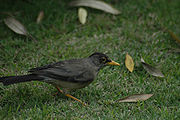
The thrushes
Thrush (bird)
The thrushes, family Turdidae, are a group of passerine birds that occur worldwide.-Characteristics:Thrushes are plump, soft-plumaged, small to medium-sized birds, inhabiting wooded areas, and often feed on the ground or eat small fruit. The smallest thrush may be the Forest Rock-thrush, at and...
are a group of passerine birds that occur mainly in the Old World. They are plump, soft plumaged, small to medium-sized insectivores or sometimes omnivores, often feeding on the ground. Many have attractive songs. There are 335 species worldwide and 4 species which occur in Chile.
- VeeryVeeryThe Veery, Catharus fuscescens, is a small thrush species. It is occasionally called Willow Thrush or Wilson's Thrush. It is a member of a close-knit group of migrant Catharus species, which also includes the cryptotaxa Grey-cheeked Thrush and Bicknell's Thrush The Veery, Catharus fuscescens, is a...
Catharus fuscescens (A) - Chiguanco ThrushChiguanco ThrushThe Chiguanco Thrush is a species of bird in the Turdidae family.It is found in Argentina, Bolivia, Chile, Ecuador, and Peru.Its natural habitats are subtropical or tropical high-altitude shrubland and heavily degraded former forest....
Turdus chiguanco - Austral ThrushAustral ThrushThe Austral Thrush, Turdus falcklandii, is a medium sized thrush from southern South America. There are two subspecies, the Magellan Thrush from south Argentina and south and central Chile, and the Falkland Thrush The Austral Thrush, Turdus falcklandii, is a medium sized thrush from southern South...
Turdus falcklandii - Creamy-bellied ThrushCreamy-bellied ThrushThe Creamy-bellied Thrush is a species of bird in the Turdidae family. It occurs in a wide range of wooded habitats in a large part of central and eastern South America. It is generally common, even in human altered habitats such as gardens and parks...
Turdus amaurochalinus (A)
Vireos
Order: Passeriformes. Family: VireonidaeThe vireo
Vireo
The vireos are a group of small to medium-sized passerine birds restricted to the New World. They are typically dull-plumaged and greenish in color, the smaller species resembling wood warblers apart from their heavier bills...
s are a group of small to medium sized passerine birds restricted to the New World. They are typically greenish in colour and resemble wood warbler
Wood Warbler
The Wood Warbler is a common and widespread leaf warbler which breeds throughout northern and temperate Europe, and just into the extreme west of Asia in the southern Ural Mountains...
s apart from their heavier bills. There are 52 species worldwide and 1 species which occurs in Chile.
- Red-eyed VireoRed-eyed VireoThe Red-eyed Vireo, Vireo olivaceus, is a small American songbird, 13–14 cm in length. It is somewhat warbler-like but not closely related to the New World warblers...
Vireo olivaceus (A)
New World warblers
Order: Passeriformes. Family: ParulidaeThe New World warbler
New World warbler
The New World warblers or wood-warblers are a group of small, often colorful, passerine birds restricted to the New World. They are not related to the Old World warblers or the Australian warblers....
s are a group of small, often colourful, passerine birds restricted to the New World. Most are arboreal, but some are terrestrial. Most members of this family are insectivores. There are 119 species worldwide and 4 species which occur in Chile.
- Tennessee WarblerTennessee WarblerThe Tennessee Warbler, Oreothlypis peregrina, is a New World warbler. It breeds in northern North America across Canada and the northern USA. It is migratory, wintering in southern Central America and northern Colombia and Venezuela, with a few stragglers going as far south as Ecuador. It is a...
Vermivora peregrina (A) - Blackpoll WarblerBlackpoll WarblerThe Blackpoll Warbler, Dendroica striata , is a New World warbler. Breeding males are mostly black and white. They have a prominent black cap, white cheeks and white wing bars. The Blackpoll breeds in northern North America, from Alaska, through most of Canada, and into the Great Lakes region and...
Dendroica striata (A) - American RedstartAmerican RedstartThe American Redstart is a New World warbler. It is the only member of its genus and is unrelated to the Old World redstarts. It derives its name from the male's red tail, start being an old word for tail.-Description:...
Setophaga ruticilla (A) - Northern WaterthrushNorthern WaterthrushThe Northern Waterthrush is one of the larger New World warblers. It breeds in the northern part of North America in Canada, and in the northern United States, . This bird is migratory, wintering in Central America, the West Indies, and Florida; also Venezuela, Colombia, and Ecuador...
Seiurus noveboracensis (A)
Tanagers
Order: Passeriformes. Family: ThraupidaeThe tanager
Tanager
The tanagers comprise the bird family Thraupidae, in the order Passeriformes. The family has an American distribution.There were traditionally about 240 species of tanagers, but the taxonomic treatment of this family's members is currently in a state of flux...
s are a large group of small to medium-sized passerine birds restricted to the New World, mainly in the tropics. Many species are brightly coloured. They are seed eaters, but their preference tends towards fruit and nectar. Most have short, rounded wings. There are 256 species worldwide and 5 species which occur in Chile.
- Cinereous ConebillCinereous ConebillThe Cinereous Conebill is a species of bird in the Thraupidae family. The term cinereous describes its colouration. It is found in Bolivia, Chile, Colombia, Ecuador, and Peru...
Conirostrum cinereum - Tamarugo ConebillTamarugo ConebillThe Tamarugo Conebill is a species of bird in the Thraupidae family.It is found in Chile and Peru, and receives its name from the tamarugo, a type of shrub to which is closely associated....
Conirostrum tamarugense - Giant ConebillGiant ConebillThe Giant Conebill Oreomanes fraseri is a small passerine bird, one of the tanager family. The only member of the genus Oreomanes it is closely related to the regular conebills Conirostrum though it differs in its larger size and nuthatch-like foraging habits.The Giant Conebill is in length and...
Oreomanes fraseri (A) - Summer TanagerSummer TanagerThe Summer Tanager, Piranga rubra, is a medium-sized American songbird. Formerly placed in the tanager family , it and other members of its genus are now classified in the cardinal family...
Piranga rubra (A) - Blue-and-yellow TanagerBlue-and-yellow TanagerThe Blue-and-yellow Tanager is a species of bird in the Thraupidae family, the tanagers.It is found in Argentina, Uruguay, Brazil, Paraguay, Bolivia, extreme northern border Chile, and Andean Peru and Ecuador...
Thraupis bonariensis
Buntings, sparrows, seedeaters and allies
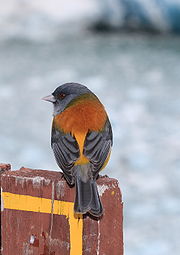
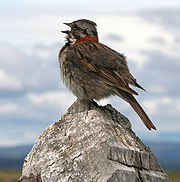
Emberizidae
The Emberizidae are a large family of passerine birds. They are seed-eating birds with a distinctively shaped bill.In Europe, most species are called buntings. In North America, most of the species in this family are known as sparrows, but these birds are not closely related to the sparrows, the...
The emberizids are a large family of passerine birds. They are seed-eating birds with a distinctively shaped bill. In Europe, most species are named as buntings. In North America, most of the species in this family are known as Sparrows, but these birds are not closely related to the Old World sparrows which are in the family Passeridae. Many emberizid species have distinctive head patterns. There are species 275 worldwide and 27 species which occur in Chile.
- Black-hooded Sierra-FinchBlack-hooded Sierra-finchThe Black-hooded Sierra-finch is a species of bird in the Thraupidae family.It is found in Argentina, Bolivia, Chile, and Peru....
Phrygilus atriceps - Gray-hooded Sierra-Finch Phrygilus gayi
- Patagonian Sierra-FinchPatagonian Sierra-finchThe Patagonian Sierra-finch is a species of bird in the Thraupidae family.It is found in Argentina and Chile.Its natural habitats are temperate forests, subtropical or tropical dry shrubland, and temperate grassland....
Phrygilus patagonicus - Mourning Sierra-FinchMourning Sierra-finchThe Mourning Sierra-finch is a species of bird in the Thraupidae family. It is found in Argentina, Bolivia, Chile and Peru. It is a vagrant to the Falkland Islands and Brazil. Its natural habitats are subtropical or tropical dry shrubland and subtropical or tropical high-altitude...
Phrygilus fruticeti - Plumbeous Sierra-FinchPlumbeous Sierra-finchThe Plumbeous Sierra-finch is a species of bird in the Thraupidae family.It is found in Argentina, Bolivia, Chile, Colombia, Ecuador, Peru, and Venezuela. Its natural habitats are subtropical or tropical high-altitude grassland and pastureland.-References:* BirdLife International 2004. . ...
Phrygilus unicolor - Red-backed Sierra-FinchRed-backed Sierra-finchThe Red-backed Sierra-finch is a species of bird in the Thraupidae family.It is found in Argentina, Bolivia, and Chile.Its natural habitat is subtropical or tropical high-altitude grassland.-References:...
Phrygilus dorsalis - White-throated Sierra-FinchWhite-throated Sierra-finchThe White-throated Sierra-finch is a species of bird in the Thraupidae family.It is found in Bolivia, Chile, and Peru.Its natural habitat is subtropical or tropical high-altitude grassland.-References:...
Phrygilus erythronotus - Band-tailed Sierra-FinchBand-tailed Sierra-finchThe Band-tailed Sierra-finch is a species of bird in the Thraupidae family.It is found in Argentina, Bolivia, Chile, Ecuador, and Peru....
Phrygilus alaudinus - Ash-breasted Sierra-FinchAsh-breasted Sierra-finchThe Ash-breasted Sierra-finch is a species of bird in the Thraupidae family.It is found in Argentina, Bolivia, Chile, Ecuador, and Peru....
Phrygilus plebejus - Canary-winged FinchCanary-winged FinchThe White-bridled Finch , also known as the Canary-winged Finch or Black-throated Finch, is a small passerine bird belonging to the genus Melanodera together with the Yellow-bridled Finch . Formerly placed in the family Emberizidae, it is now considered a tanager. It is found in grassland in...
Melanodera melanodera - Yellow-bridled FinchYellow-bridled FinchThe Yellow-bridled Finch is a species of bird in the Thraupidae family.It is found in Argentina and Chile....
Melanodera xanthogramma - White-winged Diuca-FinchWhite-winged Diuca-finchThe White-winged Diuca Finch is a species of bird in the Emberizidae family. It is found in Argentina, Bolivia, Chile, and Peru. Its natural habitat is subtropical or tropical high-altitude grassland.-References:...
Diuca speculifera - Common Diuca-FinchCommon Diuca-finchThe Common Diuca-finch is a species of bird in the Emberizidae family. It is found in Argentina, Bolivia, Brazil, Chile, and Uruguay. Its natural habitats are subtropical or tropical dry shrubland, subtropical or tropical high-altitude shrubland, and heavily degraded former forest.-References:*...
Diuca diuca - Slender-billed FinchSlender-billed FinchXenospingus is a genus of finch-like tanager. It contains a single species, the Slender-billed Finch . The slender-billed finch is restricted to southwest Peru and northern Chile, and inhabits mainly riverine vegetation along coastal valleys. It has been considered endangered due to loss of habitat...
Xenospingus concolor - Blue-black GrassquitBlue-black GrassquitThe Blue-black Grassquit is a small bird in the tanager family, Thraupidae. It was previously classified in the bunting and American sparrow family, Emberizidae. It breeds from southern Mexico through Central America, and South America as far as northern Chile, Argentina and Paraguay, and on...
Volatinia jacarina - Chestnut-throated SeedeaterChestnut-throated SeedeaterThe Chestnut-throated Seedeater is a species of bird in the Thraupidae family.It is found in Chile, Colombia, Ecuador, and Peru....
Sporophila telasco - Band-tailed SeedeaterBand-tailed SeedeaterThe Band-tailed Seedeater is a species of bird in the Thraupidae family.It is found in Argentina, Bolivia, Chile, Colombia, Ecuador, and Peru....
Catamenia analis - Black-throated Flowerpiercer Diglossa brunneiventris
- Puna Yellow-FinchPuna Yellow-finchThe Puna Yellow-finch is a species of bird in the Thraupidae family.It is found in Argentina, Bolivia, and Peru.Its natural habitat is subtropical or tropical high-altitude grassland.-References:...
Sicalis lutea - Saffron FinchSaffron FinchThe Saffron Finch is a tanager from South America and is common in both open and semi-open areas in lowlands outside the Amazon Basin. They have a wide distribution in Colombia, Venezuela , Ecuador, Peru, Brazil and Argentina...
Sicalis flaveola - Grassland Yellow-FinchGrassland Yellow-finchThe Grassland Yellow Finch, Sicalis luteola, is a small passerine bird. Despite its name, it is not a finch, but is a seedeater. These were formerly united with the buntings and American sparrows in the Emberizidae, but are now known to be tanagers....
Sicalis luteola - Bright-rumped Yellow-FinchBright-rumped Yellow-finchThe Bright-rumped Yellow-finch is a species of bird in the Thraupidae family.It is found in Argentina, Bolivia, Chile, and Peru....
Sicalis uropygialis - Greater Yellow-FinchGreater Yellow-finchThe Greater Yellow-finch is a species of bird in the Thraupidae family.It is found in Argentina and Chile.Its natural habitats are subtropical or tropical high-altitude shrubland, temperate grassland, and heavily degraded former forest.-References:* BirdLife International 2004. . Downloaded...
Sicalis auriventris - Greenish Yellow-FinchGreenish Yellow-finchThe Greenish Yellow-finch is a species of bird in the Thraupidae family.It is found in Argentina, Bolivia, Chile, and Peru....
Sicalis olivascens - Patagonian Yellow-FinchPatagonian Yellow-finchThe Patagonian Yellow-finch is a species of bird in the Thraupidae family.It is found in Argentina and Tierra del Fuego; also Chile.Its natural habitats are subtropical or tropical dry shrubland and temperate grassland.-Range:...
Sicalis lebruni - Red-crested CardinalRed-crested CardinalThe Red-crested Cardinal is a bird species in the tanager family . It was formerly placed in the Emberizidae, and notwithstanding its common name, it is not very closely related to the true cardinals .It is found in northern Argentina, Bolivia, southern Brazil, Paraguay and Uruguay...
Paroaria coronata (A) - Rufous-collared SparrowRufous-collared SparrowThe Rufous-collared Sparrow, Zonotrichia capensis, is an American sparrow found in a wide range of habitats, often near humans, from the extreme southeast of Mexico to Tierra del Fuego, and on the island of Hispaniola. It is famous for its diverse vocalizations which have been intensely studied...
Zonotrichia capensis
Saltators, Cardinals and allies
Order: Passeriformes. Family: CardinalidaeThe cardinals are a family of passerine birds that are robust, seed-eating birds, with strong bills. They are typically associated with open woodland. The sexes usually have distinct plumages. There are 43 species worldwide and 2 species which occur in Chile.
- Golden-billed SaltatorGolden-billed SaltatorThe Golden-billed Saltator is a species of cardinal in the Emberizidae family.It is found in Argentina, Bolivia, Brazil, Chile, Paraguay, Peru, and Uruguay; also the regions of the southern pantanal, along the Paraguay River.Its natural habitats are subtropical or tropical dry forests,...
Saltator aurantiirostris - Black-backed GrosbeakBlack-backed GrosbeakThe Black-backed Grosbeak, Pheucticus aureoventris is a large finch type bird found in South America in Argentina, Brazil, Bolivia, Colombia, Ecuador, Paraguay, Peru and Venezuela. They are often kept as cagebirds....
Pheucticus aureoventris (A)
Troupials and allies
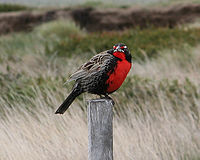
The icterids are a group of small to medium, often colourful, passerine birds restricted to the New World and include the grackle
Grackle
Grackle can refer to any of eleven black passerine birds native to North and South America. All are members of the Icterid family but belong to multiple genera.* Genus Quiscalus** Boat-tailed Grackle, Quiscalus major...
s, New World blackbird
New World blackbird
The New World blackbirds consist of 26 species of icterid birds that share the name blackbird but do not correspond with a formal taxon...
s, and New World oriole
New World oriole
New World orioles, comprising the genus Icterus, are a group of birds in the blackbird family. They are not related to Old World orioles which are in the family Oriolidae, but are strikingly similar in size, diet, behaviour and in their strongly contrasting plumage, and are a good example of...
s. Most species have black as the predominant plumage colour, often enlivened by yellow, orange or red. There are 98 species worldwide and 10 species which occur in Chile.
- BobolinkBobolinkThe Bobolink is a small New World blackbird and the only member of genus Dolichonyx.-Description:Adults are 16–18 cm long with short finch-like bills. They weigh about . Adult males are mostly black, although they do display creamy napes, and white scapulars, lower backs and rumps...
Dolichonyx oryzivorus (A) - Chestnut-capped BlackbirdChestnut-capped BlackbirdThe Chestnut-capped Blackbird is a species of bird in the Icteridae family.It is found in Argentina, Bolivia, Brazil, French Guiana, Paraguay, and Uruguay.Its natural habitats are swamps and pastureland.-References:...
Chrysomus ruficapillus (A) - Yellow-winged BlackbirdYellow-winged BlackbirdThe Yellow-winged Blackbird is a species of bird in the Icteridae family.It is found in Argentina, Bolivia, Brazil, Chile, Paraguay, Peru, and Uruguay.Its natural habitats are swamps, intertidal marshes, and pastureland....
Agelasticus thilius - White-browed BlackbirdWhite-browed BlackbirdThe White-browed Blackbird, Sturnella superciliaris, is a passerine bird in the New World family Icteridae. Despite its name and colouration, it is in the same genus as the meadowlarks, and is less closely related to the Red-winged Blackbird group...
Sturnella superciliaris (A) - Peruvian MeadowlarkPeruvian MeadowlarkThe Peruvian Meadowlark is a species of bird in the Icteridae family.It is found in Chile, Ecuador, and Peru....
Sturnella bellicosa - Long-tailed MeadowlarkLong-tailed MeadowlarkThe Long-tailed Meadowlark is a passerine bird of southern South America and the Falkland Islands, belonging to the meadowlark genus Sturnella in the icterid family....
Sturnella loyca - Bay-winged CowbirdBay-winged CowbirdThe Bay-winged Cowbird , also known as the Baywing, is a species of bird in the Icteridae family. It is currently placed in the genus Agelaioides – monotypic at present –, but has traditionally been placed in the genus Molothrus...
Molothrus badius (A) - Shiny CowbirdShiny CowbirdThe Shiny Cowbird, Molothrus bonariensis, is a passerine bird in the New World family Icteridae. It breeds in most of South America apart from the most dense jungles, mountains and deserts , the coldest southernmost regions , and on Trinidad and Tobago...
Molothrus bonariensis - Baltimore OrioleBaltimore OrioleThe Baltimore Oriole is a small icterid blackbird that averages 18 cm long and weighs 34 g. This bird received its name from the fact that the male's colors resemble those on the coat-of-arms of Lord Baltimore...
Icterus galbula (A) - Austral BlackbirdAustral BlackbirdThe Austral Blackbird is a species of bird in the Icteridae family.It is found in Argentina and Chile.Its natural habitats are temperate forests, subtropical or tropical high-altitude shrubland, and heavily degraded former forest....
Curaeus curaeus
Siskins, crossbills and allies

Finch
Finch
The true finches are passerine birds in the family Fringillidae. They are predominantly seed-eating songbirds. Most are native to the Northern Hemisphere, but one subfamily is endemic to the Neotropics, one to the Hawaiian Islands, and one subfamily – monotypic at genus level – is found...
es are seed-eating passerine birds, that are small to moderately large and have a strong beak, usually conical and in some species very large. All have 12 tail feathers and 9 primaries. These birds have a bouncing flight with alternating bouts of flapping and gliding on closed wings, and most sing well. There are 137 species worldwide and 5 species which occur in Chile.
- Thick-billed SiskinThick-billed SiskinThe Thick-billed Siskin is a species of finch in the Fringillidae family.It is found in Argentina, Bolivia, Chile, and Peru....
Carduelis crassirostris - Hooded SiskinHooded SiskinThe Hooded Siskin is a small passerine bird in the finch family , native to South America. It belongs to the putative clade of Neotropical siskins in the genus Carduelis sensu stricto....
Carduelis magellanica - Black-chinned SiskinBlack-chinned SiskinThe Black-chinned Siskin is a species of finch in the Fringillidae family.It is found in Argentina, Chile and the Falkland Islands.Its natural habitats are temperate forests and heavily degraded former forest.-References:...
Carduelis barbata - Black SiskinBlack SiskinThe Black Siskin is a species of finch in the Fringillidae family.It is found in Argentina, Bolivia, Chile, and Peru....
Carduelis atrata - Yellow-rumped SiskinYellow-rumped SiskinThe Yellow-Rumped Siskin is a species of finch in the Fringillidae family.It is found in Argentina, Bolivia, Chile, and Peru....
Carduelis uropygialis
Sparrows
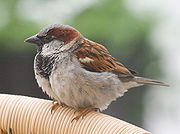
Sparrow
Sparrow
The sparrows are a family of small passerine birds, Passeridae. They are also known as true sparrows, or Old World sparrows, names also used for a genus of the family, Passer...
s are small passerine birds. In general, sparrows tend to be small, plump, brown or grey birds with short tails and short powerful beaks. Sparrows are seed-eaters, and they also consume small insects. There are 35 species worldwide and 1 species which occurs in Chile.
- House SparrowHouse SparrowThe House Sparrow is a bird of the sparrow family Passeridae, found in most parts of the world. One of about 25 species in the genus Passer, the House Sparrow occurs naturally in most of Europe, the Mediterranean region, and much of Asia...
Passer domesticus (I)
External links
- Birds of Chile for the country and by region Birdlist, multi-lingual website by country with standardized codes for abundance and seasonal presence.

